
Navigation Lights for Sailboats (And How To Read Them)

Last Updated by
Capt Chris German
June 15, 2022
Navigation lights on a sailboat can be confusing. If you understand the reason behind why they are the way they are however, they can make a lot more sense.
At their heart, sailboats are really just a power boat and as such must adhere to all power boat rules such as navigation lights. Other times however, a sailboat is classified in a special category. They have a set of additional lights they CAN show as an option, but are not always required to do so.
That’s about as clear as mud if you ask me and I contend that that is where the confusion about lighting a sailboat begins.
Just because you can show a light to identify yourself in times of low visibility, does not mean you have to and then we add in a little sibling rivalry between power and sail and things get downright adversarial when it comes to navigation and the night.
Table of contents

The USCG says You’re a Power Boat Whether You Like It or Not
Much to the consternation of many a sailor who has earned a commercial license to drive their sailboat, when you received your credential from the USCG it says you are a master of steam and power across the top with no mention of wind as a source of propulsion.
It is not until you read the back pages of your little red book that feels like a passport and looks like a US Sailing credential, that you will see the term “sail auxiliary”. That is because most of the time the U.S. Coast Guard knows that you are primarily reliant on your mechanical power to propel your vessel.
It's a sad thing, but the days of commercially viable sail boats are done and all but the most select few even have sails let alone use them as their primary power source. All sail boats by law are powerboats, but not all powerboats are sailboats.
Navigation Lights for a Power Boat
As a power boat, you are required to show certain lights and have been required to do so before power was even invented.
In the days of man powered vessels like the viking ships who relied on oars while in close quarters to power their vessels, they needed to show other boats, friend or foe, where they were by showing lanterns in the dark to identify themselves. As you know, it is a time honored rule among all the nations of the world both past and present, that you must avoid a collision at all costs while at sea and even the viking knew that you should not run into things.
By lighting the front and back of your boat, you could warn other boats of your presence as well as identify which way you were heading. As such there is a very specific rule in the Code of Federal Regulations Number 46 (CFR46 by common name) that spells out with detail how many, the color, the luminosity or brightness, the angle of visibility and the location of all of the lights required for navigation on every single boat, seaplane, submarine and other nondescript vessel conceived by man to date that they must show while underway in reduced visibility.
And there is no flexibility in the rules.
As such a power boat, and by extension all sailboats, MUST, without question show one green light on the starboard bow and one red light on the port bow and one all around white light or lights while operating in reduced visibility. These lights should shine at all 360 degrees of visibility with the bow lights shining at an angle of dead ahead to 22.5 degrees abaft the beam and the stern lights shining 225 degrees dead aft. A forward facing masthead light that is white in color shall shine forward to comply with the directive that all vessels must carry an all around white light. For more read here .
As you can see, there isn’t much wiggle room when it comes to lights that must be shown.
Sailboats get a little flexibility with lights
Sailboats however, are a little different when they are in fact sailboats, which is only when you are entirely reliant on the wind for power and in no way reliant on any mechanical or manual means of propulsion. And for good reason.
Back in the day when men were men and sailboats were wooden, fire was a major concern. Sails were coated with wax and other flammable substances and the wood on boats was saturated with oils and grease. Even the ropes were plant materials saturated with oils to keep them pliable and strong.
Add those highly flammable substances to a parching environment like the sea and you had what was essentially a giant floating tinderbox.
Then tell that giant floating tinderbox that they need to identify themselves to the world at large at night using oil lamps with flames because batteries and lights were not invented yet. It didn't take very long or very many ships burning to the water line for the Governments to say to the sailboats, you get to do things a little different.
As such, sailboats are given special dispensation when it comes to lights aloft. They don't have to show an all around white light in their rigging because no one wanted to set their rig on fire with oil lamps 60 feet up in their rig.
However, when a sailboat takes their sails down such as when they are powered or at anchor, they must resume the display of an all around white light or lights aloft. That became a real challenge with aluminum masts and the disappearance of rat lines on the shrouds because there was no easy way to climb the rig and check the bulbs up the mast on a regular basis.
Red over Green Sailing Machine
I have no idea where the history of this particular light comes from, but if you ever take a deck exam with the USCG, you better remember this mnemonic. An all around red light over an all around green may be displayed on a vessel during times of reduced visibility to indicate that a vessel is operating under sail power alone.
I won’t even speculate on how or why they came up with this particular light configuration, but if you want to use these lights as a sailing vessel, you can do so, but that means that you will need three all round lights at the top of your mast, an all around white, an all around red and an all around green, just in that order.
The red over green is to be displayed in addition to the running lights or the red and green bow lights with the 225 degree stern light. As always, when the motor comes on, so does the steaming light or the forward facing white light that is also usually about ¾ of the way up on your mast to complete the requirement of an all around white light that indicates a power vessel.
What is a “steaming light” and why are you mentioning it now?
Most sailboat electrical panels will have a switch that is labelled “steaming light” and it will only come on when your anchor light is off. This is probably the most confusing part of sailboat navigation lights so if you are confused about this, you're in good company as most people are.
A “steaming” light is named thusly, going back to the days of steam powered sailboats where when they fired up their boilers and doused the sails, they became a power boat once again. There aren’t too many steam powered boats, let alone steam powered sailboats, but the name stuck and it is a vestige of a bygone era.
Either way, when you fire up your motor, you turn on your “steaming light” and that locks out the all around white light which is used for anchoring to minimize the number of switches on your panel and reduce the number of wires in your mast. The fewer wires, the less chance of something not working or becoming disconnected.
The steaming light and the anchor light both go up the mast, but you can’t use an all around white light while using the 225 degree stern light at the deck level because to other boaters you would look like you have two white lights from the stern and that would be confusing.
The anchor light is used exclusively for anchoring while the steaming light is used to indicate you are a power vessel while underway.
As to why I am mentioning it now in the article, is because this would have blown your mind if I started with this subject cause it can be really confusing stuff.
Aspect Recognition with Lights
Remember when I said earlier that lights can help you tell others which way you are heading as well as tell you which way other boats are heading? That is called the aspect of the vessel and the USCG tests you on this for your deck exam as well.
Knowing that the bow lights go 22.5 degrees abaft the beam on both sides or 112.5 degrees on each side, and the stern light faces 225 degrees aft for a total of 360 degrees of visibility, you can tell a lot about where a boat is heading and who has the right of way.
One thing that's easy to remember is red means stop and if you see a vessel's red light, it means stop as you are the give way vessel and approaching the other vessel from his port side. Conversely it works with green as well as that means you are approaching from the other vessel's starboard side and you are the standon vessel.
If you see a red and green light equally low on the horizon, that means your heading dead on into another vessel's path and conversely if all you see is a white light low on the horizon, it means you are overtaking another vessel power or sail, we don’t care because it is an overtaking situation. However, any time you do see a white light aloft in addition to the red and green bow lights, you know you are encountering a power boat.
Then there are angular approaches as well, where you see white and red or white and green light low on the horizon. You know in that case you are seeing a portion of the bow lights and stern lights from the side approaches of a vessel. Based on which direction those lights are heading, you can deduce which way that boat is going in relation to your boat.
So put it all together and you see a green light and a white light low on the horizon with a red over green light aloft, you know that you are approaching a sailboat that is traveling to your port and that might make you the standon vessel. That is of course, if we didn’t concern ourselves with windward and leeward and port tacks and starboard tacks, but that is a discussion for another article. So stay tuned when we talk about sailing rules and the right of way. But for now, do good, have fun and sail far.
Related Articles
Capt Chris German is a life long sailor and licensed captain who has taught thousands to sail over the last 20 years. In 2007, he founded a US Sailing-based community sailing school in Bridgeport, CT for inner city youth and families. When Hurricane Sandy forced him to abandon those efforts, he moved to North Carolina where he set out to share this love for broadcasting and sailing with a growing web-based television audience through The Charted Life Television Network.
by this author

Most Recent

What Does "Sailing By The Lee" Mean?
Daniel Wade
October 3, 2023

The Best Sailing Schools And Programs: Reviews & Ratings
September 26, 2023
Important Legal Info
Lifeofsailing.com is a participant in the Amazon Services LLC Associates Program, an affiliate advertising program designed to provide a means for sites to earn advertising fees by advertising and linking to Amazon. This site also participates in other affiliate programs and is compensated for referring traffic and business to these companies.
Similar Posts

How To Choose The Right Sailing Instructor
August 16, 2023

Cost To Sail Around The World
May 16, 2023

How To Drive A Pontoon Boat
Jacob Collier
December 19, 2022
Popular Posts

Best Liveaboard Catamaran Sailboats
December 28, 2023

Can a Novice Sail Around the World?
Elizabeth O'Malley

4 Best Electric Outboard Motors

How Long Did It Take The Vikings To Sail To England?

10 Best Sailboat Brands (And Why)
December 20, 2023

7 Best Places To Liveaboard A Sailboat
Get the best sailing content.
Top Rated Posts
Lifeofsailing.com is a participant in the Amazon Services LLC Associates Program, an affiliate advertising program designed to provide a means for sites to earn advertising fees by advertising and linking to Amazon. This site also participates in other affiliate programs and is compensated for referring traffic and business to these companies. (866) 342-SAIL
© 2024 Life of Sailing Email: [email protected] Address: 11816 Inwood Rd #3024 Dallas, TX 75244 Disclaimer Privacy Policy
Boat Navigation Lights Rules: Illustrated Beginners Guide
When navigating at night, the lights on other boats are your first clue about the moving dangers around you. And your navigation lights are your first line of safety in avoiding collisions in the dark, and they tell others vessels what you are and what you are doing. The rules sound complex, but with a little understanding you can get the basics for any situation.
So what are the basic navigation light rules? For most small vessels, motoring requires red and green (port and starboard) lights, and a white light visible in all directions around the boat. This is almost always a stern light and a masthead light on sailboats. Boats under sail require port and starboard lights, and a white stern light. Sailboats below sixty-five feet may show a tricolor light at the masthead instead of side and stern lights when sailing.
That's it, in a nutshell. There's a little more to it, as the rules change with different sizes and there are some specifics about angles of display for the colors. Identifying other ships at sea requires more study, but the basics are the same. And it's not much trouble to make sure you've always got the proper lights on your vessel.
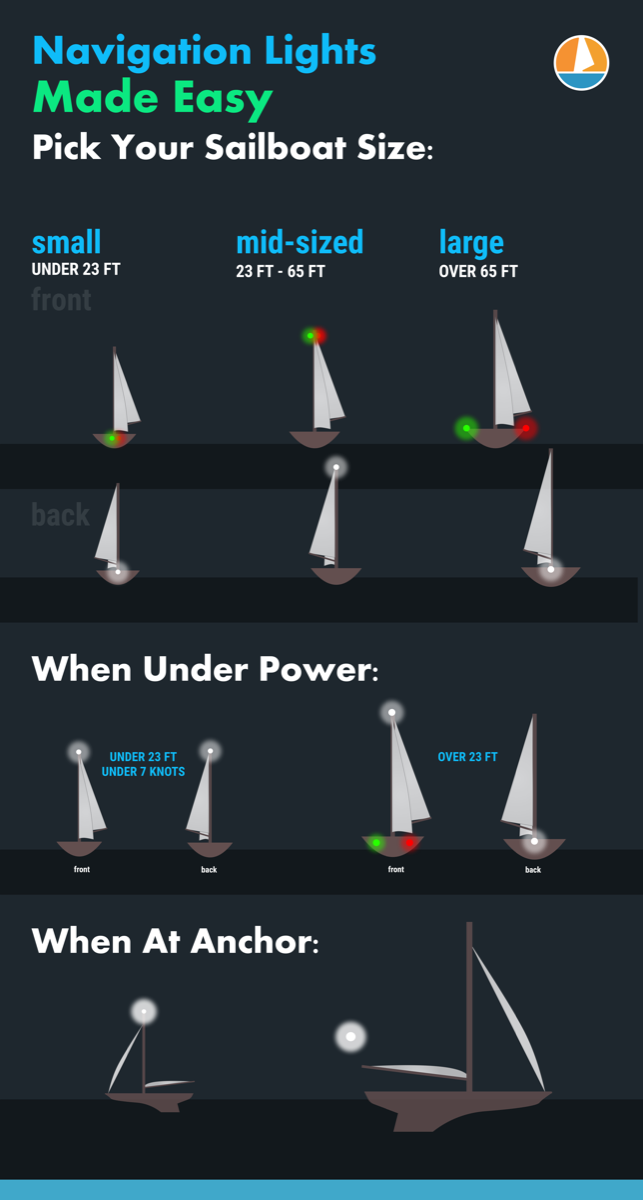
On this page:
What are the official colregs rules for your sailboat, what about the uscg (united states coast guard) rules, lighting at anchor, identifying the boats around you.
The International Regulations for the Prevention of Collision at Sea , abbreviated "COLREGS" is very specific about the lights required, their shapes and sizes, and the distance they must be visible. For the smaller boat, the following definitions apply.
- Masthead Light - a white light placed centerline on the boat showing an arc of 225 degrees with 112.5 degrees either side of the front of the vessel.
- Sidelights - A red light on the port side and a green light on the starboard. They must show an arc of 112.5 degrees from centerline of the bow.
- Stern light - A white light on the stern of the boat showing an unbroken arc of 135 degrees from centerline of the vessel.
- All-round light - A light showing in an unbroken arc of 360 degrees.
The good news is you need not measure these angles. Any properly installed USCG or COLREGS approved light which will cover the correct arcs. If you have to replace the original light from your boat, make sure it's with an approved replacement.
Lights When Sailing
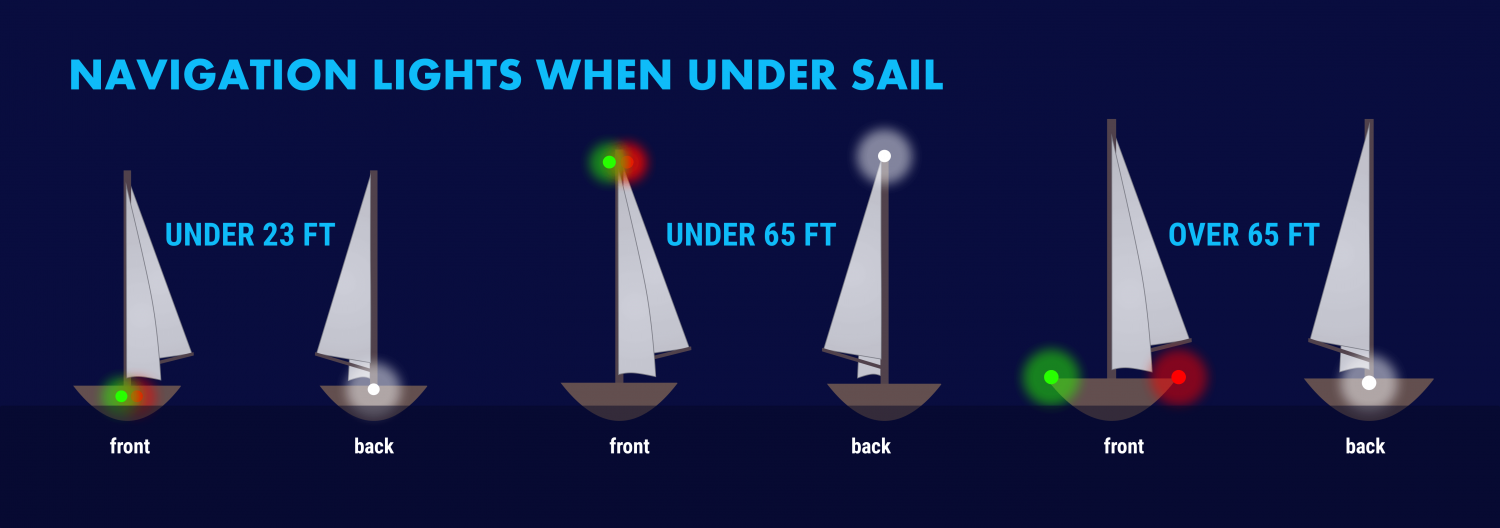
The specific rules for a sailboat under sail are in COLREGS Rule 25 and vary slightly with the size of the boat. A sailboat powering is considered a power boat and falls under in Rule 23.
- Under 23 feet (7 meters) - side lights and a stern light, possible. If these lights can not be displayed a light must be kept at hand to help avoid a collision. This can be a bright flashlight.
- Over 23 feet - Side lights visible to one nautical mile and stern light visible for two.
- Vessels under 65 feet may combine both sidelights into a single lantern on the bow.
- May show a tricolor light on the masthead instead of sidelights and a stern light. It's one or the other though, do not show these lights at the same time .
- Masthead light must be visible for three nautical miles, all other lights must have a two nautical mile visibility.
- Side lights must be separated.
- May not show a masthead tricolor light.
- Masthead light must have five nautical mile visibility, all other lights must be visible for two nautical miles.
- Optional masthead lights - any vessel under sail may display a red light over a green light at the masthead with sidelights and stern light. The red over green may NOT be displayed with a masthead tricolor light. It's one set or the other.
Lights When Motoring
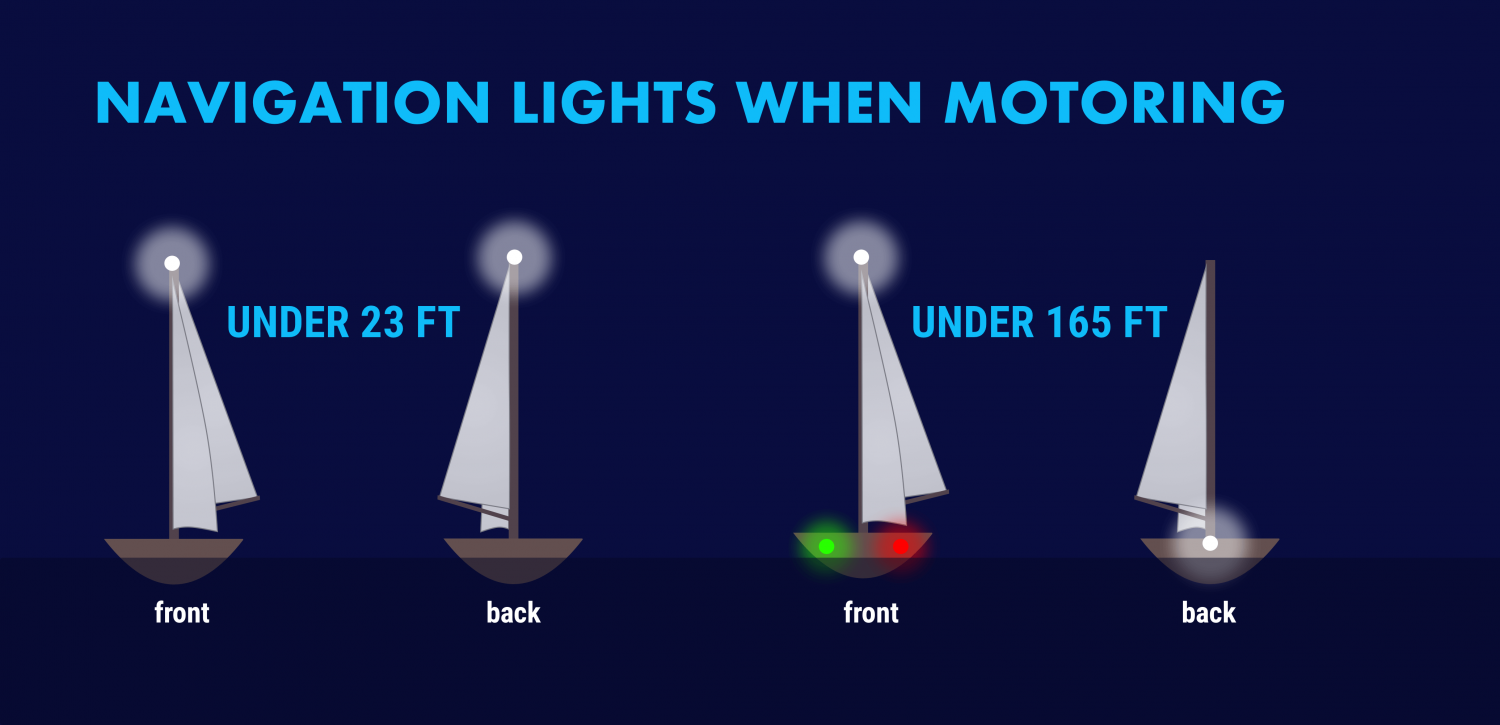
For all navigational purposes a sailboat under power is considered a power boat. This includes motor sailing - if the engine is on and providing propulsion you are on a power boat, even if the sails are up . This applies to navigation lighting, sound signals in fog and limited visibility, and rights of way.
Sailboats under 50 meters under power need to show:
- A masthead light
- Stern light
A power-driven vessel under 23 feet (7 meters) that does not exceed seven knots of speed may display an all around white light, though sidelights should be used if available.

The USCG has published its own "Rules of the Road" that are based on the COLREGS. In addition, it has rules for the "Inland Waterways" for rivers, inland lakes and the Great Lakes.
The good news is this has no impact on what you have to do with your own boat.
They mostly relate to lighting changes on towed vessels like barges and tugs. For example, a vessel towing or pushing another vessel in the ocean under COLREGS shows two masthead lights, sidelights and a stern light, whereas in Inland Waterways the towing or pushing vessel displays two yellow towing lights instead of a white stern light.
If you sail on lakes, rivers or the Great Lakes where towed commercial traffic is common you should learn the inland lights, but coastal or ocean sailors will never see these.
When you anchor outside a designated mooring field, you should display an all around white light at the masthead or as high in the boat as practical.
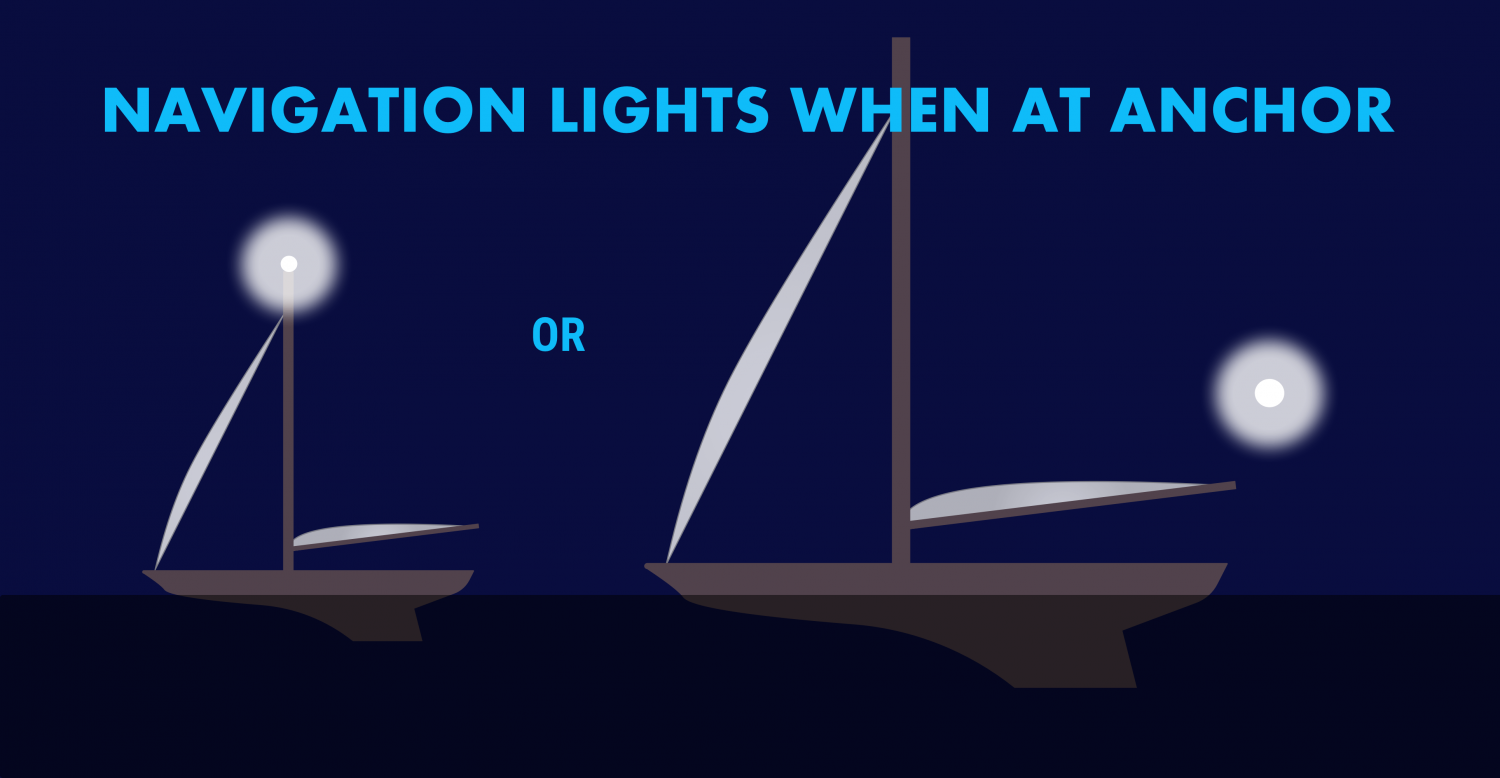
If your boat is large and has a very tall mast, you may wish to display another light closer to the waterline. Boats approaching in the dark may not see a light on a mast sixty or seventy feet in the air when they are close to your boat.
We use a simple garden path light on our stern when we anchor, left in a rod holder or flag socket. It comes on automatically at dusk and is a cheap and easy way to be more visible. There is no specific rule stating you can not display more lights than required, or the nature of any lights beyond the required all around light.
The COLREGS also specify that a round black "daymark" should be displayed in the rigging of any vessel at anchor. Very few small vessels observe this, however it is the correct display for a vessel in an anchorage.
If you tie to a mooring in a marked mooring area you are not required to display anchor lights, but there is no harm in doing so.
The other important reason to know your lights is to figure out what's going on around you at night. The water may be ablaze with white, red, green and other lights at night and they are your first key to avoiding collisions and problems.
All combinations of lights for fishing boats, commercial vessels, and so on are outside this post‘s scope. The odds are small you will encounter a submarine, seaplane or hovercraft at night, but there are regulations regarding specific lighting for each of those vessels!
There are a few fundamentals to help you figure out what that is you see on the horizon, which way it is going, and whether it is a danger to you.
Port Wine is Red
The fundamental rule is that red sidelights will ALWAYS be on the port side of a vessel, and green lights will always be on starboard. However, some vessels can use all around red and green lights for other purposes, though those will be higher than sidelights.

The light‘s on a ship is not important, some large tankers and freighters will have their sidelights far aft and put them on the superstructure for better visibility. It is not safe to assume that sidelights you can see are on the bow of large vessels .
When you can see the color, you know which way the bow is pointing. If it's red, it's pointing more or less to the left and will travel in that direction. A green light shows it is heading more or less to your right.
If you can see the red and green lights at the same time, you are looking directly at the bow of the vessel. When you are far away, this isn‘t as alarming as if you are close crossing. Seeing red and green lights together on a vessel is something you never want to see for long.
Be aware of red and green lights used in combination with other red, green and white lights. These may not be running lights and could have other significance.
Tankers, Freighters and Large Ships
Tankers, freighters and large ships will have side lights, a stern light and a masthead light. In addition, on vessels over 50 meters there will be a second masthead light further aft and higher than the forward light. The masthead light positions are a better tipoff to the bow direction and how far from the bow the sidelights might be. Remember - on a large vessel the sidelights may not be at the bow or even close to it.
USCG Inland Rules allow for a second all-around white light on large vessels on the Great Lakes instead of a second masthead light.
Fishing Boats
Fishing boats engaged in fishing will have more complex light displays. When they aren't fishing, they will show lights like any power vessel, but Rule 26 spells out light combinations that vary by the fishing activity being done. In general:
- Boats which are Trawling but not making headway will display a green all-around light over a white all-around light , and a masthead light aft of these lights. Boats making headway while trawling will show these lights, plus sidelights and a stern light.
- A vessel fishing other than trawling will show a red all-around light over a white all-around light . When making way they will also show sidelights and a stern light.
- If a vessel has gear more than 150 meters away from the boat, it will show a second all around light in the direction of the gear. The best rule is to give fishing boats as wide a berth as you can at night. They're easy to pick out if you check the top light configurations but their course may be difficult to predict.
Towing and Pushing
Towed vessels can be the most dangerous to cross, but they have the most lights to tell you what is happening. Refer to COLREGS or the USCG Rules of the Road Rule 24 for all combinations You can pick a tow/push vessel out with the following lights:
- Two or three masthead lights in a vertical line. Three masthead lights shows a tow over 200 meters. Additional masthead lights may show for larger tow vessels.
- A towing light (yellow light with the same characteristics as a stern light) directly above the stern light.
- The will also have side lights and a stern light.
- The towed vessel will show sidelights and a stern light. Lighting may vary under USCG inland rules, where towing lights may replace stern lights. Learn these differences if this is your regular cruising ground. If you think there is a tow ahead of you, always go well behind the aft most set of lights. Never go between a tow and avoid crossing ahead if possible as it may restrict their maneuverability.
Special Situations
There are several rare situations you may encounter. As a general rule, if there are a lot of lights and you don't understand them look for the sidelights on a moving vessel. If you can find them and figure out the direction it is moving, it makes the vessel easier to avoid. Stay well clear of lights you do not understand if you can avoid them without risk.
Most of these signals are used by larger, commercial vessels and you will not need them.
They use these light combinations with other light combinations. For example a towing vessel may also be restricted in maneuverability, and a vessel constrained by draft will show running lights if moving.
- Not Under Command - two all around red lights in a single line
- Restricted in Ability to Maneuver - red, white then red in a single line
- Constrained by draft - three all around red lights
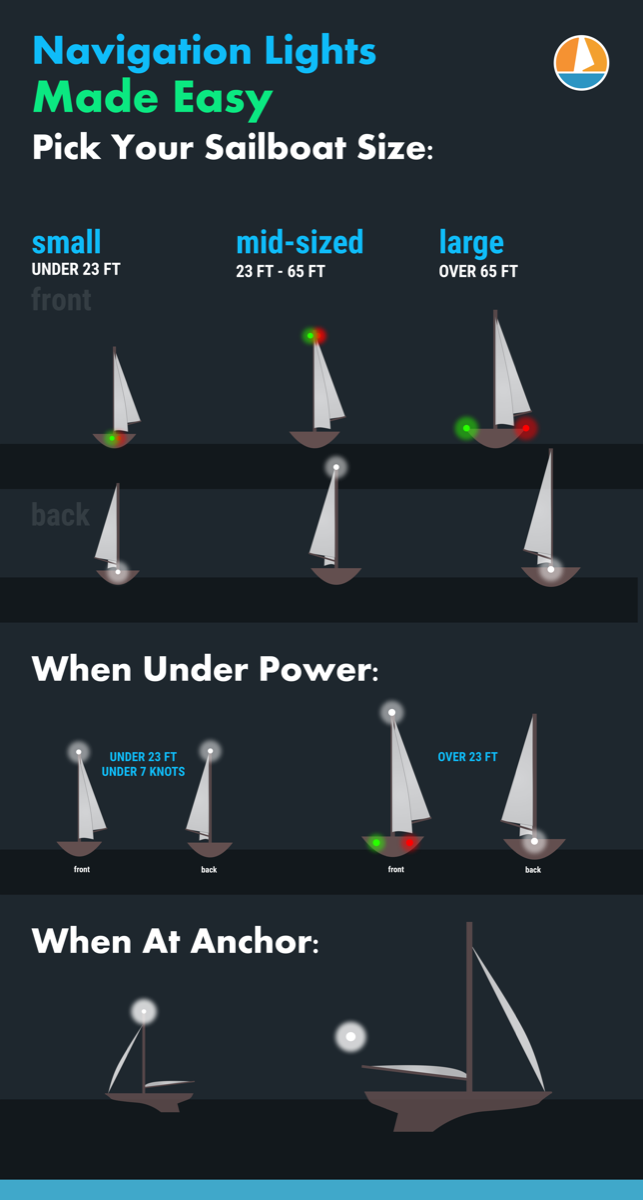
Leave a comment
You may also like, 17 sailboat types explained: how to recognize them.
Ever wondered what type of sailboat you're looking at? Identifying sailboats isn't hard, you just have to know what to look for. In this article, I'll help you.

The Ultimate Guide to Sail Types and Rigs (with Pictures)
Own your first boat within a year on any budget.
A sailboat doesn't have to be expensive if you know what you're doing. If you want to learn how to make your sailing dream reality within a year, leave your email and I'll send you free updates . I don't like spam - I will only send helpful content.
Ready to Own Your First Boat?
Just tell us the best email address to send your tips to:
Sailboat Steaming Light: A Crucial Navigation Aid for Safe Night Sailing
by Emma Sullivan | Aug 12, 2023 | Sailboat Maintenance

Short answer sailboat steaming light:
A sailboat steaming light is a white, forward-facing light used to indicate that a vessel is underway under power during nighttime or restricted visibility conditions. It is typically mounted on the mast or near the navigation lights and helps other vessels identify the sailboat’s position and direction.
What is a Sailboat Steaming Light? A Comprehensive Guide
Sailing enthusiasts, both experienced sailors and newcomers to the sport, often come across various terminologies associated with boats and their equipment. One such term is the “steaming light.” In this comprehensive guide, we will delve into everything you need to know about a sailboat steaming light and its importance.
So, what exactly is a sailboat steaming light? A sailboat steaming light refers to a white navigation light mounted on or near the front of a sailing vessel. It serves as an essential safety feature when sailing during low visibility conditions, such as at dusk or dawn. When turned on, the steaming light ensures that your boat remains visible to other vessels in order to prevent collisions.
The primary purpose of a sailboat steaming light is to indicate to other boaters whether your vessel is under power (engine) or not. This becomes crucial when sharing busy waterways with motorized boats that may have limited maneuverability compared to sails .
In addition to indicating if your boat is powered by an engine, the sailboat steaming light often works in conjunction with another essential navigation light called the bow (or sidelight). The combination of these lights helps mariners determine which way your boat is moving – whether it’s coming towards them or moving away from them.
According to international marine regulations (COLREGs), all sailing vessels are required to display proper lighting for navigation and collision avoidance purposes. This includes having a functioning steaming light mounted at least 1 meter above the vessel’s deck level and visible up to 3-5 nautical miles depending on the size of your boat.
It’s important to note that while many modern boats come pre-equipped with built-in lighting systems compliant with maritime laws, older or custom-built vessels might require additional modifications or upgrading for compliance. Therefore, it is advisable for boat owners to familiarize themselves with their specific country’s regulations to ensure they meet the necessary requirements .
Now, let’s talk about some clever tips and tricks regarding sailboat steaming lights.
Firstly, in order to maximize visibility, it is crucial to keep your steaming light clean and free from any obstructions. Regularly inspect the light for dirt, corrosion, or damage that might hinder its performance. Even a small layer of grime or a cracked lens can significantly reduce its visibility range, potentially jeopardizing your safety on the water.
Another important consideration is understanding how to interpret other boats’ lighting signals. By being aware of what each navigation light represents and their combinations, you can quickly assess if an approaching vessel is likely to pose any risks. For instance, if you see a sailboat displaying only its red or green sidelight without a visible white steaming light , it suggests that it may be solely under sail power and not utilizing its engine. This knowledge allows you to anticipate their movements better and make quicker decisions when adjusting your own course.
Lastly, remember that having a properly functioning steaming light should never give you a false sense of security while sailing in low visibility conditions. Always exercise caution and maintain a lookout for other vessels by employing all available means such as radar or AIS (Automatic Identification System). Additionally, using common sense navigation techniques like reducing speed or altering course when necessary can go a long way in ensuring safe passage.
In conclusion, understanding the purpose and importance of a sailboat steaming light is vital for any sailor seeking to enjoy their time on the water while prioritizing safety. By adhering to international regulations and maintaining the integrity of this navigation tool through regular inspections and cleaning practices, you can navigate confidently during low visibility situations. So next time you set sail at dusk or dawn with your trustworthy vessel equipped with a reliable steaming light – stay informed, stay cautious, and most importantly – enjoy your adventure!
How to Install and Maintain a Sailboat Steaming Light: Step-by-Step Instructions
Installing and maintaining a sailboat steaming light may seem like a complex task, but with proper guidance and a systematic approach, it can be accomplished with ease. This blog post will provide you with step-by-step instructions on how to install and maintain a sailboat steaming light to ensure safe sailing adventures.
Step 1: Gather the necessary tools Before starting the installation process, make sure you have all the required tools at hand. These may include a screwdriver set, wire strippers, electrical tape, heat shrink tubing, crimping tool, voltage tester, and of course, your new steaming light.
Step 2: Select the ideal location for the steaming light To begin installing your sailboat’s steaming light , choose an appropriate spot on the mast or deck where it will provide maximum visibility without obstructing any other fixtures or rigging. Ensure that there are no obstacles blocking its beam and that it aligns properly with navigation regulations.
Step 3: Disconnect the power source Before starting any electrical work on your boat , always disconnect the power source to reduce the risk of accidents. Locate the main switchboard or battery panel and turn off all power supply related to lighting systems.
Step 4: Remove old fixture (if applicable) If you already had a pre-existing steaming light in place that needs replacing or maintenance, start by carefully removing it from its mountings. This might involve unscrewing bolts or unclipping fixtures – proceed with caution to avoid damage or injury.
Step 5: Install mounting brackets/plates Having removed the old fixture (if present), now is an excellent opportunity to install new mounting brackets or plates for your new steaming light. Choose sturdy materials such as stainless steel or reinforced plastic that can withstand harsh marine conditions while providing reliable support for your device.
Step 6: Wire connections Next comes wiring your new steaming light into place correctly. Begin by identifying the positive and negative terminals on the light itself. Then, strip approximately half an inch of insulation from the boat’s electrical wires to expose the copper strands. Connect the appropriate wires, ensuring a secure fit using crimping tools or soldering if necessary. Remember to cover exposed connections with marine-grade heat shrink tubing to protect against corrosion.
Step 7: Securely mount and align your steaming light After completing the wiring, carefully attach your steaming light to the previously installed brackets or plates. Double-check that it is firmly secured and aligned precisely according to navigation regulations and guidelines.
Step 8: Test for functionality Once you have completed all connections and mounting tasks, turn on your sailboat’s power supply specifically related to lighting systems. Use a voltage tester to check if there is electricity flowing through your newly installed fixture. Confirm that it illuminates correctly without any flickering or issues.
Maintaining Your Sailboat Steaming Light:
Now that you have successfully installed your sailboat steaming light take note of these key maintenance tips:
1. Regular inspection: Perform routine checks before each sailing trip or at least once every few months when in use. Look for cracks, loose connections, corroded wires, or any signs of wear and tear.
2. Cleaning: Keep your steaming light clean from salt residue or dirt accumulation by simply wiping it down with a soft cloth dipped in freshwater after each outing on the water.
3. Bulb replacement: If your sailboat steaming light uses replaceable bulbs rather than LED technology, keep extra bulbs on board for emergencies or as backups during longer voyages.
4. Check regulations regularly: Stay up-to-date with any changes in international navigation requirements regarding sailboat lighting systems – this will help you ensure compliance while maintaining safety standards onboard.
By following these step-by-step instructions and practicing proper maintenance techniques, you are well-equipped in safely installing and maintaining a sailboat steaming light. Remember, a well-lit sailboat ensures not only your safety but also the safety of others navigating nearby. Happy sailing!
Frequently Asked Questions about Sailboat Steaming Lights: All You Need to Know
Introduction: Steaming lights are an essential component of any sailboat ‘s lighting system, ensuring safe navigation and visibility in low-light conditions. However, like many aspects of sailing, there are often questions surrounding the use and regulations of these lights. In this blog post, we aim to address some frequently asked questions about sailboat steaming lights and provide you with a comprehensive understanding of their purpose, placement, and guidelines. So grab your favorite beverage, sit back, and let’s dive into the world of sailboat steaming lights!
1. What are sailboat steaming lights? Sailboat steaming lights are white navigation lights mounted on top of the mast or another elevated position on a sailboat . They emit a forward-facing light beam that allows other vessels to see your boat from a distance at night or during times of reduced visibility.
2. What is the purpose of sailboat steaming lights? The primary purpose of sailboat steaming lights is to ensure safety by making your vessel visible to other boats in order to prevent collisions. These white navigation lights indicate the presence and direction of your boat when it is underway under engine power instead of relying solely on sails.
3. When should I use my sailboat’s steaming light? According to international maritime regulations (COLREGs), you should switch on your sailboat’s steaming light whenever you are motoring or using an engine while sailing between sunset and sunrise or in periods of limited visibility due to weather conditions such as fog or heavy rain.
4. Where should I place my sailboat’s steaming light? Traditionally, the common practice is placing the sailboat’s steaming light at least one meter below its anchor light. The exact height may vary depending on the size and type of your vessel, so it is advisable to consult relevant boating authorities for specific rules and recommendations .
5. Are there any requirements regarding the intensity of sailboat steaming lights? Yes, there are regulations concerning the minimum intensity of sailboat steaming lights outlined in COLREGs. The light should be bright enough to be visible from a distance of at least two nautical miles on a clear night.
6. Can I use my anchor light as a substitute for a sailboat steaming light? No, it is not recommended to use an anchor light in place of a dedicated steaming light. Anchor lights have different specifications, including their color (white) and angle of visibility (360 degrees), which differ from sailboat steaming lights. It is always advisable to comply with the regulations and install the appropriate lighting for each specific purpose.
7. Can I use LED bulbs for sailboat steaming lights? Yes! LED bulbs are becoming increasingly popular for sailboat lighting systems due to their energy efficiency, longevity, durability, and bright output. Remember to choose LED bulbs specifically designed for marine applications and follow installation guidelines provided by the manufacturer.
8. Do powerboats or motor vessels require similar navigation lights ? While some aspects may overlap, powerboats or motor vessels have different regulations governing their navigation lighting systems compared to sailboats . Motor vessels typically require stern lights, masthead lights, sidelights (red/green), and all-round white lights instead of dedicated steaming lights found on sailing vessels .
Conclusion: Sailboat steaming lights serve as crucial safety features ensuring your vessel ‘s visibility during nighttime or low-light conditions while using engine power instead of sails. Understanding their purpose, correct placement, intensity requirements, and compliance with international maritime rules will help enhance safety at sea while creating an enjoyable sailing experience for you and other boaters venturing into the night waters!
Choosing the Right Sailboat Steaming Light for Your Vessel: Expert Tips and Recommendations
When it comes to sailing, safety is paramount. One key aspect of ensuring your safety on the water is having the right sailboat steaming light for your vessel. The steaming light serves a crucial purpose in providing visibility to other boaters, especially during low-light conditions or when navigating through foggy areas.
With a plethora of options available, selecting the right steaming light can be overwhelming. Thankfully, we’ve compiled a comprehensive guide with expert tips and recommendations to help you make an informed decision.
1. Understand the Regulations: Before diving into the vast selection of steaming lights, familiarize yourself with the regulations applicable to your area of navigation. Different regions have varying requirements regarding mounting position, brightness specifications, and color codes. Understanding these regulations ensures not only compliance but also enhances safety by ensuring your visibility to nearby vessels is optimal.
2. Consider LED Technology: In recent years, LED technology has revolutionized marine lighting due to its energy efficiency and long lifespan. Investing in an LED-based steaming light not only saves power but also reduces maintenance costs in the long run. Additionally, LEDs offer better durability against shocks and vibrations compared to traditional bulbs – critical factors for seafaring enthusiasts.
3. Assess Visibility Range: Visibility range is a vital aspect when choosing a sailboat steaming light as it directly affects your ability to be noticed by other boaters from afar. Opt for lights that provide impressive visibility even in reduced visibility conditions such as fog or rain. A powerful steaming light will ensure that other boats can spot you early on, preventing potential collisions or accidents.
4. Durability and Waterproofing: Sailing exposes all elements of your boat to harsh conditions like saltwater exposure and strong winds. It’s essential to select a robustly built steaming light that can withstand these challenges without compromising its performance. Look for high-quality materials, such as corrosion-resistant stainless steel, and ensure the light is fully waterproof to prevent any malfunctions in wet conditions.
5. Mounting Options: Consider your vessel’s structure and layout when selecting a steaming light. Some sailboats have specific mounting points designed for these lights, while others may require additional modifications or customizations. It’s advisable to choose a steaming light that complements your boat’s aesthetics and integrates seamlessly into its design without compromising functionality.
6. Think about Power Consumption: Efficient energy use is not only eco-friendly but also crucial during long journeys where power resources may be limited. Opt for a low-power steaming light that remains highly visible without draining excessive energy from your battery bank. This ensures you can maintain safety on the water throughout extended trips without encountering power-related issues.
7. Read Reviews and Seek Expert Advice: Lastly, never underestimate the importance of reading reviews from fellow sailors who have previously used the product you’re considering. Their feedback can provide valuable insights into the durability, performance, and overall satisfaction with different steaming lights available in the market. Additionally, consulting with marine professionals or experienced sailors can help you uncover hidden gems or consider aspects you might have overlooked.
By following these expert tips and recommendations, you’ll be well-equipped to choose the right sailboat steaming light for your vessel – one that ensures optimal visibility, adheres to regulations, and enhances overall safety while reflecting your personal style as an avid sailor. Happy sailing!
Common Issues with Sailboat Steaming Lights and Troubleshooting Techniques
Steaming lights are an essential component of any sailboat’s navigation system. These small yet powerful lights are mounted on the front of the mast and aimed forward, illuminating the boat’s path during night sailing and in low visibility conditions. However, like any electrical device on a boat , steaming lights can experience various issues that can hamper their functionality. In this blog post, we will explore some common problems sailors encounter with their steaming lights and introduce troubleshooting techniques to overcome these challenges.
One of the most prevalent issues with steaming lights is flickering or intermittent operation. This problem can stem from several reasons, including loose connections, damaged wiring, or a faulty bulb. To start troubleshooting, it is advisable to inspect all connections and ensure they are tight and free from corrosion. Dirty or corroded connectors can disrupt the flow of electricity and cause flickering.
Next, examine the wiring for any signs of wear or damage. Over time, exposure to saltwater, sunlight, and general wear and tear can lead to degraded insulation or broken wires. Inspect each wire carefully for fraying or cuts. If you notice any issues with the wiring, it is crucial to replace it promptly to avoid electrical shorts or more significant problems down the line.
If the connections and wiring appear intact, there may be an issue with the bulb itself. Unscrew the steaming light cover carefully (making sure it is not hot) and inspect the bulb for signs of damage such as discoloration or a broken filament. If necessary, replace the bulb with an appropriate fitment using gloves or a cloth to prevent oils from your skin affecting its lifespan.
Another common problem encountered by sailors is insufficient brightness from their steaming light. This issue can dismay sailors who rely on these lights for safe navigation during night voyages. The most likely culprits behind dim illumination include voltage drop due to undersized wires or excessive resistance in a worn-out switch.
To troubleshoot this issue, begin by inspecting the wires connected to the steaming light. Ensure they are of an appropriate gauge for the distance they run and the expected amperage draw. If undersized wires are identified, consider replacing them with thicker ones capable of carrying higher currents without significant voltage drop.
Additionally, check the switch that controls your steaming light. Over time, switches can degrade due to constant use and exposure to harsh marine conditions. If you notice any signs of wear or erratic behavior in your switch, replacing it may be necessary to restore optimal brightness from the steaming light.
Lastly, a thorough examination of connections throughout the electrical system is essential in troubleshooting issues with steaming lights. Make sure all connections on other components related to the light’s operation – such as circuit breakers or fuses – are secure and free from corrosion. Intermittent connectivity at these points can affect proper functioning and lead to dimming or flickering.
In conclusion, sailboat steaming lights can encounter several common issues that compromise their functionality during critical moments at sea. By understanding these problems and employing effective troubleshooting techniques, sailors can rectify most concerns related to flickering lights, insufficient brightness, or intermittent operation. Regular inspections, proper maintenance practices, and prompt replacement of faulty components will ensure that your sailboat’s navigation system operates flawlessly when darkness falls upon your nautical adventures !
The Importance of Properly Functioning Sailboat Steaming Lights for Safety at Sea
Title: The Indispensable Sentinel: The Crucial Role of Sailboat Steaming Lights in Ensuring Safety at Sea
Introduction:
Picture this scenario: a sailboat gracefully glides through the darkness, seemingly isolated from the world. But amidst the tranquility lies an ardent guardian – its steaming lights. These unassuming yet critically important fixtures play a pivotal role in ensuring the safety of sailors and vessels alike while navigating the vast expanse of our mysterious seas . In this enlightening discourse, we delve into the significance of properly functioning sailboat steaming lights and their invaluable contribution to maritime safety.
1. Enhancing Visibility and Navigational Confidence:
Steaming lights act as beacons piercing through the obscurity of night, guiding mariners toward safe passages. Positioned atop or near a vessel’s mast , these illuminators offer reassurance by marking its location and width. A fully functional steaming light enables sailors to gauge distances accurately, discern potential obstacles ahead, and maintain proper course heading—an essential aspect when maneuvering amidst treacherous waters.
2. Safeguarding Against Collisions:
One cannot stress enough how crucial it is for sailboats to have properly operating steaming lights during nighttime travels. By serving as warning signals to other vessels in proximity, these luminous sentinels aid in preventing catastrophic collisions at sea. Their bright glow provides clear indications of ongoing traffic patterns, allowing nearby ships to adjust their course accordingly—a lifeline that assures peace of mind while exploring unchartered waters .
3. Regulating Vessel Sizing Perception:
Properly functioning steaming lights not only promote collective safety but also help mitigate misunderstandings regarding vessel size estimation—one perilous situation where assumptions about dimensions can lead to disastrous consequences. Inaccurate perception may cause smaller boats to misjudge distances or misinterpret larger vessels’ intentions, putting both parties at risk. Consistent illumination displayed by working steaming lights eliminates size-related uncertainties, thereby ensuring a harmonious coexistence among seafarers.
4. Compliance with Maritime Regulations:
Furthermore, adherence to maritime regulations is of paramount importance for every responsible sailor venturing into the open seas . Numerous maritime authorities such as the International Maritime Organization (IMO) mandate that vessels maintain operational steaming lights in accordance with specific guidelines. Neglecting these requirements not only compromises safety but also exposes sailors to potential legal ramifications—incurring fines or even vessel detention—underscoring the absolute significance of properly functioning steaming lights .
5. Foolproofing Unforeseen Situations:
Imagine being caught unprepared amidst dense fog or inclement weather conditions; sailboat steaming lights act as our steadfast allies during such adversities. In circumstances where visibility is severely compromised, these luminous guides penetrate the mist, aiding in establishing a clear line of sight while minimizing risks of accidents or collisions. Their vigilance endows sailors with a genuine sense of security and bolsters their ability to navigate challenges in uncharted territories.
Conclusion:
As illuminated guardians traversing darkened waters, sailboat steaming lights assume an unparalleled significance in safeguarding lives and preserving vessels’ integrity at sea. Operating at the intersection of compliance, navigational precision, and collective security, these often undervalued fixtures weave an intricate safety net capable of averting disasters and serving as beacons of hope during tumultuous voyages. By acknowledging their indispensable role and ensuring their proper functioning, mariners can embark on each journey with confidence—knowing that their trusty sentinels will guide them safely through the vast expanse of our enigmatic oceans.
Recent Posts

- Sailboat Gear and Equipment
- Sailboat Lifestyle
- Sailboat Maintenance
- Sailboat Racing
- Sailboat Tips and Tricks
- Sailboat Types
- Sailing Adventures
- Sailing Destinations
- Sailing Safety
- Sailing Techniques
- Members Forum
- Log In / Create Account
Navigation Lights at Night
by Harbor Sailboats | Dec 4, 2020 | Blog | 1 comment

Great article! Boat lights are the means of communication between sailing vessels. These lights are also a tool to let my presence known even from a distance.
Submit a Comment Cancel reply
You must be logged in to post a comment.
Latest Blog Posts
- Talk and Walk
- Sailing Lessons in San Diego
- Water in the Bilge
- Bow Standing
- Gear then Steer
- BOAT OF THE YEAR
- Newsletters
- Sailboat Reviews
- Boating Safety
- Sailing Totem
- Charter Resources
- Destinations
- Galley Recipes
- Living Aboard
- Sails and Rigging
- Maintenance

Proper Nav Lights Keep You Safe
- By Steve D' Antonio
- Updated: December 7, 2011
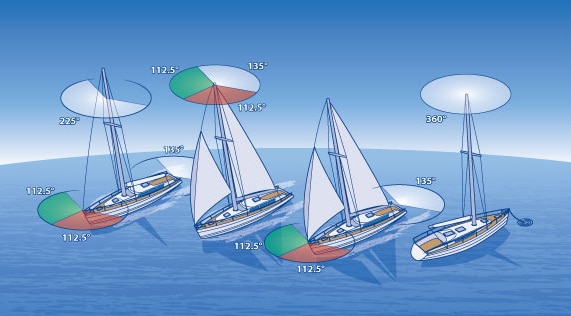
Running Lights
There’s one sure way to avoid being run down when sailing at night: Be seen. Make yourself visible by putting your running lights in good working order, and ensure that they comply with U.S. Coast Guard regulations. If you’re involved in a collision and your navigation lights aren’t compliant, you may be found at fault.
The most common problems involve how and where the lights are mounted. Take a careful look at each fixture; depending on the size of your vessel and its configuration of sail and power, your boat may have as many as six navigation lights: port, starboard, stern, masthead tricolor, steaming, and anchor. Make sure that no light is obstructed in any way. The usual suspects include davit-hung tenders and other stern-mounted gear as well as mast-mounted radar domes. In some cases, I’ve seen the transom itself block a portion of a stern light’s required arc of visibility.
Additionally, be sure that your side lights are mounted on surfaces that are vertical and parallel with the boat’s centerline. Side lights that are mounted on bow rails and are parallel with the rail rather than the centerline can have the effect of overlapping their red and green arcs when viewed from angles other than dead ahead, making it seem to others who are forward of you as if you’re heading directly for them when, in fact, you may not be.
Stern and masthead lights should be vertical and mounted perpendicular to the vessel’s centerline.
Side lights must be installed above the sheer line. Even if this weren’t a regulation, I’d strongly recommend replacing ones embedded in the hull; they’re less visible, particularly when the boat’s heeled, and are exposed to spray and a greater chance of immersion.
Tricolor lights can only be used when under sail. Under power, conventional deck-level lights and a steaming light must be used. At no time can both deck and tricolor lights shine simultaneously. In order to avoid this nav-light faux pas, consider installing a two-position switch (supplied by a nav-light circuit breaker) that activates either the steaming or sailing configuration.
When selecting, inspecting, and replacing navigation lights, be sure that they carry a U.S. Coast Guard approval label. Select fixtures that are appropriate for your vessel’s length, and make sure that the wattage of every bulb is correct.
Imagine disassembling a light housing with a small screwdriver while you’re hanging over a bow rail or sitting in a bosun’s chair; I prefer to use incandescent fixtures that can be serviced without tools. Remember, too, that while L.E.D. lights are virtually exempt from bulb failure, they’re no less prone to wiring and connection issues. Make certain that all nav-light wiring is fully waterproofed using either heat-shrink tubing and/or sealant. Wiring to masthead lights should be run so that its weight isn’t supported by the fixture. Navigation lights are your ally in the safe handling of your vessel. Make sure that yours can always be seen.
Steve D’Antonio offers services for boat owners and buyers through Steve D’Antonio Marine Consulting .
- More: boat maintenance , How To , maintenance , safety equipment
- More How To

Cruising with a Pet

Fatty Goodlander: Have Little, Want Less

How to Ride a Wave

How To Prioritize Your Sailboat’s Spring Checklist

A Big, New World

Cruising World On Board: Windelo 50

Into the Mystic: A Pacific Northwest Adventure

- Digital Edition
- Customer Service
- Privacy Policy
- Email Newsletters
- Cruising World
- Sailing World
- Salt Water Sportsman
- Sport Fishing
- Wakeboarding
Sign up now for our WhatsApp newsletter and receive a FREE SVB set of playing cards!
Get the latest SVB news via WhatsApp and/or SMS!
- Spare parts
- SVB@Youtube
- My SVB Account
- Compare list
Are you missing items that you have already placed in your shopping cart? Log in to see your saved items.
- Boat Safety Equipment
Navigation Lights on Sailing Yachts and Motor Boats

Navigation lights ensure the safety of everyone at sea. The Convention on the International Regulations for Preventing Collisions at Sea (IMO COLREG 72) precisely sets out the guidelines for navigation lights, i.e., displaying lights, their range (distance from which the light is visible), as well as how they should be constructed and assembled. Our guide is of interest to sailors and sports boats enthusiasts with boats up to 20 m in length.
Regulations and official certifications:
When must navigation lights be displayed, what are the regulations concerning the use of navigation lights at sea, how do i know that my lights are eu-compliant, what is a ce mark, how are navigation lights defined, minimum range of navigation lights:.
- From what distance must lights be visible?
- What lights are required for my boat?
What lights must be displayed on a sailboat or rowing boat with a motor?
What lights should i exhibit when at anchor, what lights should be displayed to show that a vessel is unable to manoeuvre.
- How do I indicate that my vessel has run aground?
Navigation lights – Conventional and LED:
What distinguishes led from conventional navigation lights.
- Replacement bulbs for conventional & LED lights
What are the advantages of LED navigation lights?
Switching from conventional to led navigation lights.
According to COLREGs part C, rule 20), navigation lights must always be used on board from sunset to sunrise or during the day if visibility is poor.
Please refer to the German Traffic Regulations for Navigable Maritime Waterways , §8 -10 and Preventing Collisions at Sea. Part C - Lights and Shapes. rules 20 - 31, and annexes I 1. - 14 for the exact wording.
NOTE: Vessels that are authorised to fly the German flag are generally only permitted to use approved navigation lights and sound signalling devices.
EU approval can be identified via the wheel mark symbol and the notified body number. BSH approved navigation lights (previously DHI) are marked with a model number (e.g., BSH/00/01/90).
However, even older lights with DHI approval that have already been installed maintain their approval, despite the changes made by the BSH.
In addition to the wheel mark symbol and German BSH approval, some lights are also approved by other countries, such as RINA (Registro Italiano Navale), MCA (Maritime and Coastguard Agency) and the USCG (United States Coast Guard). These are now recognised, provided the approval comes from the national approval body recognised in the country of origin.
National bodies whose accreditation is currently recognised in Germany:
The wheel mark symbol indicates approval of the Marine Equipment Directive (MED). This approval is valid for all EU member states, both for commercial vessels and recreational shipping.
0098 = Notified Body number (here 0098 = Germanischer Lloyd in Hamburg) 18 = year in which the mark is affixed, here 2018

- A CE mark is a symbol that must be affixed to a product by the manufacturer before it is sold on the European market. It indicates that the manufacturer is aware of the specific requirements for the product in question and that it fulfils the requirements of relevant European product directives. A CE mark does not supersede approval according to collision prevention regulations.
- Navigation lights are defined in detail by the International Maritime Organization (IMO), according to the International Regulations for Preventing Collisions at Sea, 1972 (COLREGs) Convention on the International Regulations for Preventing Collisions at Sea, 1972), in sections C and D. The following rules apply:
Which navigation lights are required on board according to IMO COL REG?
Definitions according to the 1972 International Regulations for Prevention of Collisions at Sea (COL REG 72):

1. Side lights for starboard and port
A green light on the starboard side and a red light on the port side, which shine from dead ahead in an arc of 112.5° aft to a point 22.5° abaft the beam (behind the beam) on either side of the vessel. On ships of less than 20 metres in length, the two individual sidelights may be replaced by a dual-colour combined light. This must be centrally located on the bow and stern axis.

2. Stern light
A white light mounted as close to the stern as possible and shines dead ahead in an arc of 135° (67.5° to each side). The mounting height should be aligned to the height of the side lights and should never be higher.

3. Three-colour light for sailing vessels (sailing lights)
On sail boats up to a length of 20 m, the side light and stern light can be combined into one three-colour light mounted on top of the mast. However, as soon as the sail boat's motor is engaged, the use of a three-colour light is no longer permitted. The rules for motor-powered vessels then apply.

4. Mast-head light
A white light placed over the centre line of the vessel and shines dead ahead in an arc of 225° (from straight ahead up to 22.5° more aft than crosswise to each side). The mounting height should be at least 1 m higher than the side lights. In the past, the mast-head light was also referred to as a steam boat light or steamer light, as it is only seen on ships that operate under engine power.

5. Signal light or all-round light
A light that shines in a complete circle of 360°. It may emit white, red or green light, depending on use. Examples of use: All sailboats and motorboats at anchor must exhibit a white anchor light . Ships over 12m in length must, if necessary, display vessel-in-distress lights (two red signal lights) placed at a vertical distance of at least 12 m. The distance between such lights must not exceed 1 m.
From what distance must navigation lights be visible?
The range indicates the distance from which the light can be seen. The minimum ranges of navigation lights are defined according to ship size as follows::
Best-seller Hella marine

Note: When sailing boats are powered by a motor, the rules for motorboats apply and not for sailboats. The tricolour light may then no longer be displayed.

Displaying lights for sailboats up to 20 m
1 x red port side light
1 x green starboard light
1 x stern light
Also allowed:
1 x red all-round light on or near the mast top
1 x green all-round light on or near the mast top

1 x 3-colour light

Sailing vessels under 7 m (dinghies or small sports boats)
If, due to their design, no modern lights can be fitted, sailing vessels under 7 m in length and vessels being rowed must always carry an electric torch or lantern showing a white light, ready to exhibit in sufficient time to prevent a collision.
1 x Electric light or a torch with white light

Motorised vessels over 12 m
Lights used must be either / or:
1 x white masthead light fore

1 x dual colour light

Motorised vessels under 12 m
Alternatively, motorised vessels under 12 m can exhibit the following lights:
1 x white all-round light

Motorised vessels under 7 m and 7 knots maximum speed (small motor boats, dinghies or inflatables):
Motorised vehicles under 7 metres and with a maximum speed of no more than 7 knots can display the following navigation lights: all-round lights, portside and starboard lights.
The following applies in accordance with German Traffic Regulations for Navigable Maritime Waterways (SeeSchStrO): If, due to their design, no lights can be displayed (e.g., dinghies), sailing vessels under 7 m in length and 7 knots maximum speed must carry an electric hand-held spotlight or a torch to prevent collisions in the dark.
Left: 1 x white all-round light, 1 x red port side light, 1 x green starboard light
Right: 1 x hand-held spotlight or torch
Best-seller Aqua Signal Conventional

Best-seller Aqua Signal LED

Provided no engine power is used, the rules for sailboats apply. Motor-sailing vessels must display a large black cone pointing downwards when sailing during the day or at good light.
For vessels travelling under sail or at rudder during darkness or at reduced visibility, the rules for carrying lights for motorised boats automatically apply. This then depends on the length of the boat.
By day with a black cone, tip pointing downwards.
Visual signalling equipment

Torches & Spotlights


How must navigation lights be mounted on board?
Navigation lights must be securely mounted perpendicular to the waterline. Mast-head lights and stern lights should both be placed above the keel line.
At anchor during daylight? This must be displayed with a black anchor ball.
If the vessel is anchored outside of an area of water known by the River and Shipping Police Authority as an anchorage and berth for small vessels, this must be indicated as follows:
A black ball by day, 1 x white all-round light at night

Marker Lights

If your boat is unable to manoeuvre*, this should be indicated as follows:
Stationary: 2 x red all-round light, 2 x black ball, one below the other (during the day)
Moving: 1 x red port side light, 1 x green starboard light, 1 x white stern light
* A vessel is described as if, due to exceptional circumstances (e.g., rudder failure or engine malfunction), it cannot manoeuvre as prescribed and therefore cannot avoid another vessel.

How do I indicate correctly that my sailboat or motorboat has run aground?
If your boat has run aground, this should be indicated as follows:
2 x red all-round light, 1 x white all-round light, 3 x black ball, one below the other (during the day)
Manufacturers that specialise in navigation lights such as Aqua Signal or Hella Marine supply a wide range of internationally approved navigation lights which work with conventional (with BSH bulb) or with permanently installed light-emitting semiconductor components (LEDs). The bulbs required for operation are an integral part of the approval. Replacement bulbs must also be certified so that approval / your insurance protection is guaranteed. Ships under 20 m: Stern and anchor lights require BSH-approved light bulbs with 10 watts, all other navigation lights 25 watts.
All series listed above with BAY15d sockets could alternatively be operated with a high-Power LED . The big advantage in doing so is that the LED is suitable for multiple voltages (10-30 V) and consumes just 3 watts during operation. Since the light colour, range of light or beam angle can vary depending on the housing, this light is NOT yet internationally approved.
Spare Bulbs - Conventional & LED

Energy consumption on sailing ships is, as ever, a topic of significant interest. This is especially true for blue-water sailors who like to sail longer distances at a stretch. The arguments for converting to LED technology are as follows:
- High energy savings due to the low power consumption
- Long lifespan (over 10,000 hours)
- MultivoltTM technology (10-30V) with greater tolerance to voltage peaks
- Compact and light housing constructions
- Waterproofed, hermetically sealed housings
- Maintenance free
When switching completely from conventional navigation lights to LED lights, lights with the BSH seal of approval / EU wheel mark meet all the requirements in terms of light colour (no risk of blue tint), range of light and beam angle, and that you are travelling in accordance with KVR.
Navigation lights with LED technology

Replacing your navigation lights is often easy to do as manufacturers usually use the same mounting points for LED lights or have an adapter plate for further use of existing drill holes:

Adapter plate

Share our guide on social media

Written by our SVB (technical) experts
Our SVB safety experts regularly carry out maintenance checks and tests on our safety products, such as life jackets, life rafts etc. They test products and base their recommendations on many years of experience and their own know-how.

- CLASSIFIEDS
- NEWSLETTERS
- SUBMIT NEWS

The Best Lopolight Navigation Lights for Sailboats from 12 to 20 Meters
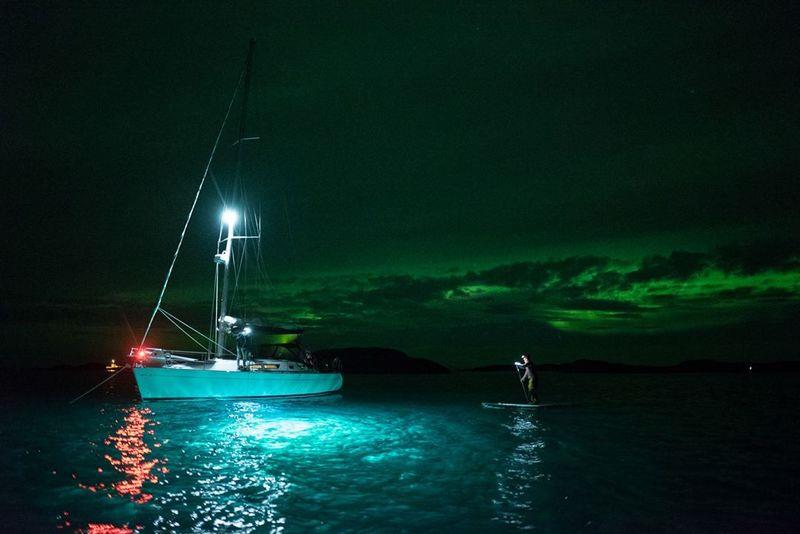
Related Articles
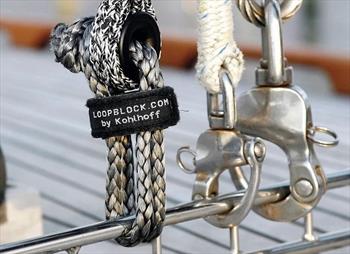

Please verify you are a human
Access to this page has been denied because we believe you are using automation tools to browse the website.
This may happen as a result of the following:
- Javascript is disabled or blocked by an extension (ad blockers for example)
- Your browser does not support cookies
Please make sure that Javascript and cookies are enabled on your browser and that you are not blocking them from loading.
Reference ID: 5b176716-0e10-11ef-becf-c3e3bfa5d810
Powered by PerimeterX , Inc.

- 949.858.8820

Shopping Cart
- MARELON ® ABYC Complete Valve Kits
- Whisker Pole Selection Guide
- MARELON Pro Series Valve Guide for OEMs

GENERAL SAILING
- Steering Control Arm
Boom Vangs / Yacht Rod
- Deck Light / Spreader Light
Combination Deck / Steaming Light
- Light Guard
- Floating Man Overboard Strobe Light
- Racing Signal Flag Label
- Equipment & Usage Labels
Sail Protection / Anti-chafe
- Jib Rollers
- TURNBUCKLE COVERS
- Shackle Guards / Lifeline Rollers
Cleats, Chocks, Handles, Hinges
- Cleats & Line Chocks
- Transom Steps & Handles
- Hinges - Non-corroding
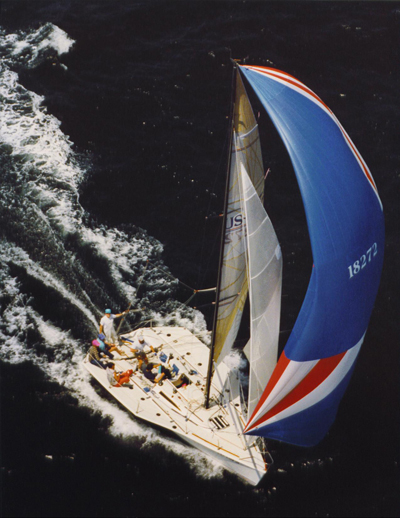
Poles & Accessories
Whisker poles & equipment.
- Downwind Pole Selection Guide
- Twist Lock Poles
- Tri-reacher Pole
- Aluminum Line Control Poles
- 50 / 50 Aluminum Carbon
- Carbon Fiber Line Control Poles
- Pole End Fittings & Collars
- Lock Repair Kits
- Sprits - Multi Hull Sprit Kit
Spinnaker Poles & Equipment
- Spinnaker Pole Overview
- Small Boat Spinnaker Pole Kits
- Aluminum Spinnaker Poles
- Carbon Fiber Spinnaker Poles
- Spinnaker Pole Order Form
- Reaching Struts
- Awning Poles
- End Fittings
Mast Pad Eyes, Cars & Track
- Mast Pad Eyes
- Track Stops
Pole Chocks
- Deck Mounted
- Stanchion Mounted
- Mast Mounted
- Adapting Collars
- Aluminum Tubing
Cabin Accessories
Boat care products.
- Tea Tree Power ® Anti-mildew
- Eco-Tank Pro™
- MareLube™ Lubricants
- ReFresh™
- Lanocote ® Anti-corrosion Lubricants & Coatings
- Equipment & Usage Labels
- Pure Water+™ Replacement Filters
- Sink Drains
- Floating MOB Marker Buoy Light
- Vented Loops/Replacement Vent Caps
- Bulkhead Fittings
- Valves for Sinks, Heads and Engine compartments
Booms & Leisure Furl
- Leisure Furl® Boom System
Cranes, Davits, Hoists
- Nova Lift™
- Nova Davit™
- Motor Mate™
Safety Equipment
- Man Overboard Poles & Accessories
- Lightning Master™ (Static Dissipater)
- Sta-plug ® Emergency Plug
- Sta-plug ® Mini™ Emergency Plug
- TRU-PLUG™
- Floating Man Overboard Strobe Light / Buoy Light
- Rail Mount Options
Tiller Extensions & Lock Box
- Fixed Length Ball & Golf Grip
- Carbon Fiber & Ocean Racer
- Tubing Clips
- Plumbing Systems - Marelon ®
- Replacement Parts
- Tea Tree Power ® Anti-Mildew
- ROLL STABILIZER / FLOPPER STOPPER
- Tea Tree Power ®
- Sta-Plug ® (New! Mini)
- Sta-Plug ® (Large)
- CLEATS & LINE CHOCKS
- TRANSOM STEPS & HANDLES
- HINGES -- NON-CORRODING
- DECK LIGHT / SPREADER LIGHT
- COMBINATION DECK / STEAMING LIGHT
- LIGHT GUARD
- FLOATING MAN OVERBOARD STROBE LIGHT
- QUIK Davit™
- RADAR MASTS
- PROP & BOTTOM
- PureWater+™ by forespar ®
- AWNING POLES
- REPLACEMENT PARTS
- MARELUBE™ EXTRA

- Marelon Summary
- New Marelon Products
- What Marelon ® Is
- Marelon ® On ABYC ISO
- Ball Valves
- Flange Mounting Seacocks
- Tank Vent / Deck Plug
- Flush Deck Drains
- Motor Well Drains
- Garboard Drains
- Utility Drains
- Engine Flush Out
- Hose Adapters / Tailpipes
- Clear View Hose Connectors
- Pro Series Seacocks
- Pro Series Remote Operated Valve Thru Hull
- Flowtech™ Performance Valves
- Flush Head / Threaded
- Mushroom Head / Threaded
- Mushroom Head / Hose Barb
- Scoop Strainers
- Vented Loops
- Water Strainers
- Y-valves & Connectors

- Leisure Furl ® Sailing Center
- Offshore™
- Coastal™
- Maintenance
- Manuals & Tech Bulletins
- Testimonials
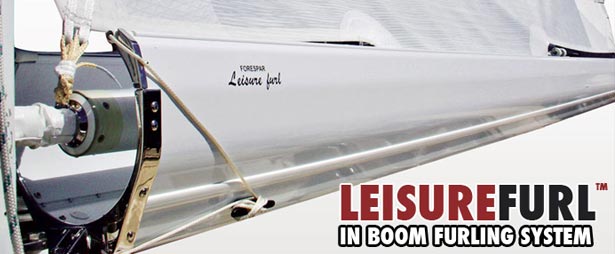
- Contacting Customer Service
- Product Policies
- Shipping, Returns & Exchange Policy
- Conditions Of Use
- Privacy Notice
- Warranty Information
- Dealer Support
- Carbon Fiber Spinnaker Pole Order Form
- Aluminum Spinnaker Pole Order Form
- Video How To's
- Tech Tips How To's
- Install & Maintenance How To's
- Diagram How To's
- Featured Products
- Boat Show Schedule
- Leisure Furl ® Sailing Center
- Newsletter Archive
- Product Catalog
- Product Brochures
- Helpful Boating Resources

- Shipping, Returns & Exchange Policy
- International Ordering & Shipping Policy
- Privacy Policy
- Press Releases
- Team Photos
- What Customers Say
- International Agents
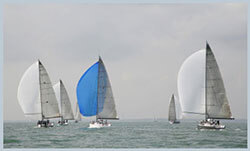
COMBINATION DECK/STEAMING LIGHT– ML-2
- Steaming Light meets Coast Guard requirements for yachts up to 65' LOA
- Separate Switching for Deck and Steaming lights
10 Watt Boy Light Bulb is easily replaceable (WN-211).8 amps
Deck Light features identical to ML-1
- Provided with 6” of triple-lead wire
- Weighs 7 oz – measure 5 ¾” vertically
- Molded body
Available in black finish only
- Mast Light Chafe Guard (sold separately) will also work with Aqua Signal model 254047-7 combo light
This top selling light has been redesigned to improve access for bulb replacement. At the same time, the deck light/bulb assembly has been updated with a new prismatic reflector for enhanced deck illumination.
- Installation/Maintenance
- Spare Parts
"Steaming Light meets Coast Guard requirements for yachts up to 65’ LOA*
Separate Switching
Provided with 6” of triple-lead wire Weighs 7 oz – measure 5 ¾” vertically
New molded body
Mast Light Chafe Guard will also work with Aqua Signal model 254047-7 combo light
Replacement bottom ring for NL-1 & 2. Top bulb ML-2 Bottom Bulb ML-1 & 2. Top Clear Lens, ML-2 only.
CALL FORESPAR
if (document.cookie.match(/wholesale=[a-zA-z0-9]+/)) {document.write(' ')}

Enter Your Email Address to Get our eNewsletter
- Subscriber Only Specials
- Tech Tips From the Pros
- How-To Videos
- Early Notice On Promotions
- New Products
- Dealer Locator
Forespar Products Corp. 22322 Gilberto Rancho, Santa Margarita, CA 92688, 949.858.8820

Website Created by: Digital Design Solutions

- Sports & Outdoors
- Boating & Sailing
- Electrical Equipment
Navigation Lights

Enjoy fast, free delivery, exclusive deals, and award-winning movies & TV shows with Prime Try Prime and start saving today with fast, free delivery
Amazon Prime includes:
Fast, FREE Delivery is available to Prime members. To join, select "Try Amazon Prime and start saving today with Fast, FREE Delivery" below the Add to Cart button.
- Cardmembers earn 5% Back at Amazon.com with a Prime Credit Card.
- Unlimited Free Two-Day Delivery
- Streaming of thousands of movies and TV shows with limited ads on Prime Video.
- A Kindle book to borrow for free each month - with no due dates
- Listen to over 2 million songs and hundreds of playlists
- Unlimited photo storage with anywhere access
Important: Your credit card will NOT be charged when you start your free trial or if you cancel during the trial period. If you're happy with Amazon Prime, do nothing. At the end of the free trial, your membership will automatically upgrade to a monthly membership.
Return this item for free
Free returns are available for the shipping address you chose. You can return the item for any reason in new and unused condition: no shipping charges
- Go to your orders and start the return
- Select the return method

Image Unavailable

- To view this video download Flash Player
Five Oceans Combination Masthead and Deck Light, LED Masthead Deck Spreader Light, 12V, Vertical Mount for Sailboat - FO3837
Purchase options and add-ons, about this item.
- HIGH-PERFORMANCE LED: Masthead Light - Feature 14 Super Bright White LEDs. Deck Light - Feature a Super Bright MR16-12 LED G4 type. Working Voltage: 12V DC. Wattage: 0.5W Masthead Light, 1.5W Deck Light. Amperage Draw: 0.25A. LED Lifetime: 100,000 hours
- DURABLE MARINE GRADE MATERIALS: Design of Solid Marine Grade Polycarbonate Housing and Lens. The polycarbonate housing is shock-resistant, non-corrosive, non-magnetic, and seawater resistant. Waterproof: IP65
- EASY INSTALLATION: Flexible side mounting flaps allow vertical mounting on a wide range of masts. Mounting Procedure for Smaller Diameter Masts - Fit Up to 3 Inches Minimum Mast Wide, this will prevent an open gap in the sides of the masthead light portion of the fixture
- WIDE APPLICATION: This Light is designed to be wrapped around the front of the mast to light the deck and be the spreader light required at night. Meets the 2 NM Rule and it is recommended for Vessels up to 40 Feet
- MEASUREMENTS: 6 3/4 Inch (171mm) L, 6 1/2 Inch (165mm) H, 3/4 Inch (70mm) D. Pre-wired Red, Black, and White Cord, Certificate CE, and RoHS. Vertical Surface Mount. Mounting Hardware: 2 Pre-drilled Mounting Holes
Additional Details

Frequently bought together

Similar items that may deliver to you quickly

From the brand

Visit the Store

Deck Accessories

Boat Lifestyle and Accessories

Maintenance

At Five Oceans, we are passionate enthusiasts of the incredible on-board experiences, be it sailing, fishing, cruising or practicing water sports. With over 40 years of expertise and an unbridled love for marine activities, we provide a vast selection of products for all boat owners. We understand the need for dependable, cost-effective, and premium-quality products that boaters and their families can trust.
Product Description
Technical specifications, measurements & mounting.

Product information
Technical details, additional information, warranty & support, compare with similar items, looking for specific info, customer reviews.
Customer Reviews, including Product Star Ratings help customers to learn more about the product and decide whether it is the right product for them.
To calculate the overall star rating and percentage breakdown by star, we don’t use a simple average. Instead, our system considers things like how recent a review is and if the reviewer bought the item on Amazon. It also analyzed reviews to verify trustworthiness.
Customers say
Customers like the performance, ease of installation, and value of the vehicle light assembly. For example, they mention that the lights work well, it's easy to wire up, and it'll be a cost-effective replacement for more expensive units. That said, some complain about the flexibility and screws. Opinions are mixed on quality.
AI-generated from the text of customer reviews
Customers like the performance of the vehicle light assembly. They mention that it works well, has no issues, and the lights are bright.
"Easy install and works just as they said . Brighter than I expected." Read more
"...This mast/deck light is not one of them.The lights do work and are bright. That's the positive...." Read more
"...The light DOESN'T WORK without a bulb ! Very poor Customer Service." Read more
"...I used a heat gun to bend the tabs to fit my mast and have not had any issues with it ...." Read more
Customers find the installation process of the vehicle light assembly to be easy. They mention that it's a good light, easy to wire up, and modestly bright.
"...the flaps to my mast...but that took 60 seconds per side and was very easy to do . Lights are bright. Only been up a week so we'll see how it lasts...." Read more
" Easy install and works just as they said. Brighter than I expected." Read more
"It's a good light, easy to wire up and modestly bright, but the lights are different color!..." Read more
" Easy to install " Read more
Customers appreciate the value of the vehicle light assembly. They mention it's a cost effective replacement for more expensive units and a cheap item that you can get for half the price under other.
"A big plus for having an LED deck light, and for being sold at a reasonable price compared to Aqua Signal which is the exact same thing as this for..." Read more
" Cost effective replacement for more expensive units..." Read more
" Great for the price ..." Read more
"This is a cheap item that you can get for half the price under other brands...." Read more
Customers are mixed about the quality of the vehicle light assembly. Some mention it's a high quality light, easy to wire up, and modestly bright. They say it'll be a great light for low electric consumption. However, others say it feels light and cheaply made. They also say the light has a questionable longevity.
"... Lights are bright . Only been up a week so we'll see how it lasts...." Read more
"Easy install and works just as they said. Brighter than I expected ." Read more
"Was able to hook it up to existing wiring without any problems. Very bright . Appears durable for marine use." Read more
"...Draws a lot less current and very bright. The construction is pretty poor but so was the old one...." Read more
Customers are dissatisfied with the flexibility of the vehicle light assembly. They mention that the flanges to wrap the mast are not flexible enough, and the light housing does not flex enough to really conform to the mast. They also say that bending the ears was hard to do without distorting the body.
"...There was plenty of room on the C22. Bending the ears was really hard to do without distorting the body...." Read more
"...on smaller boats (mine is 22 feet long) the light housing does not flex enough to really conform to the mast without bending the housing and..." Read more
"The fastening flanges to wrap the mast are not flexible enough to wrap a 6" mast. Causing the mounting bracket to pull away from the fixture...." Read more
Customers are dissatisfied with the screws in the vehicle light assembly. They mention that the screws are not in the same place as expected, and the centerline screws prevent a flush install.
"...I will agree that there are a couple screws on the back that do have the points out JUST far enough that, depending on mounting, could contact the..." Read more
"...The screws are not in the same place as you would expect and the housing will snap if you bend the ears to fit around most masts. Returned." Read more
" centerline screws prevent flush install ..." Read more
Customers are dissatisfied with the size of the vehicle light assembly. They mention that it's not made to fit smaller masts and is not suitable for small boats.
"...these things are so flimsy and cheaply made, and (b) it can not be made to fit smaller masts ...." Read more
"Good light. Not for small boats ...." Read more
" Will not fit on standard sail boat masts ..." Read more
Reviews with images

- Sort reviews by Top reviews Most recent Top reviews
Top reviews from the United States
There was a problem filtering reviews right now. please try again later..
Top reviews from other countries

- Amazon Newsletter
- About Amazon
- Accessibility
- Sustainability
- Press Center
- Investor Relations
- Amazon Devices
- Amazon Science
- Sell on Amazon
- Sell apps on Amazon
- Supply to Amazon
- Protect & Build Your Brand
- Become an Affiliate
- Become a Delivery Driver
- Start a Package Delivery Business
- Advertise Your Products
- Self-Publish with Us
- Become an Amazon Hub Partner
- › See More Ways to Make Money
- Amazon Visa
- Amazon Store Card
- Amazon Secured Card
- Amazon Business Card
- Shop with Points
- Credit Card Marketplace
- Reload Your Balance
- Amazon Currency Converter
- Your Account
- Your Orders
- Shipping Rates & Policies
- Amazon Prime
- Returns & Replacements
- Manage Your Content and Devices
- Recalls and Product Safety Alerts
- Conditions of Use
- Privacy Notice
- Consumer Health Data Privacy Disclosure
- Your Ads Privacy Choices
- Gift Certificate
- --> Login or Sign Up

Shop by Category
- All LED Replacement Bulbs
- BA15S/BA15D Bayonets (1141/1142/1156)
- BAY15D Indexed Bayonet (1157)
- BA9S Miniature Bayonet
- Edison - Screw-Type
- Festoon (SV8.5)
- Fluorescent Style
- MR11 & MR16
- PAR 36 Sealed-Beams
- Socket Adapters
- Boat Specific LEDs
- All LED Fixtures
- Interior LED Fixtures
- Exterior LED Fixtures
- All Navigation Lights
- Nav Lights By Function
- Economy Series LED Navigation Lights
- USCG Certified Navigation Lights
- LED Retrofit Bulbs for Nav Lights
- Portable LEDs & Flashlights
- All Cruising Necessities
- Comfortable Cruising Accessories
- Wireless Headset Communicators
- Chemicals and Compounds
- All Marine Wind Generators
- MarineKinetix MK4+ Wind Generator
- Wind Generator Installation Accessories
- Spare & Replacement Parts
- Marine Energy Products
- All Wiring & Electrical
- Marine Wire & Accessories
- Power Supplies & Voltage Converters
- LED Dimmers & Switches
- Wireless Remote Controls
- Dusk-to-Dawn Photocells
- 12VDC Device Chargers
- All Cristec / Scheiber OEM
- Cristec Products
- Scheiber Products
- Mantus Anchors
Shop by Brand
- MarineKinetix
- Cruising Solutions
- Sirius Signal
- View all Brands
- Navigation Lights
LED Masthead Steaming Light

- Create New Wish List
- Similar Products
Product Description
Marinebeam's NavLight™ Series 1 3NM USCG-Certified 225° Masthead (Steaming) Light.
These attractive and economical 225° white LED lights face forward on the boat's centerline, and are used to indicate that a vessel (up to 50 Meters in length) is underway and is power-driven. Used on motor-craft and sailboats under power.
Like all Marinebeam products, our LED navigation lights have our integrated internal Constant-Current chipset, so they can operate at voltages from 9-33VDC. This means they are great for both 12VDC and 24VDC applications. This also provides protection from over-voltage conditions, transient surges, and provides for consistent output and safety even at very low battery levels.
Our navigation lamps do not emit RF harmful interference, and are EMC certified to EN55022, EN61547, and EN60945 so they will not interfere with radios, sensitive electronics, or GPS signals. This lamp has 3NM visibility and has been certified to meet the USGC and ABYC A-16 standards for vessels up to 50 Meters (164 feet) in length. Includes two (2) stainless steel mounting screws, and 8' of duplex 18AWG tinned wiring to allow power connection to be below decks, if desirable.
Specifications:
- Voltage: 9-33VDC
- Power: 2 Watts
- Visibility: 3NM
- Housing Color: Black or White
- Output Color: White
- Ingress Protection: IP67 (fully sealed)
- Approvals: USCG 33CFR183.810, ABYC A-16, EMC EN55022, EN61547 & EN60945
- Dimensions: 3-7/16" (H) x 3-1/16" (W) x 2" (D)
Mounts using (2) vertically aligned screws 50mm apart - adopted by the new Perko NaviLED PRO for direct replacement.
Product Videos
Custom field, product reviews, write a review.
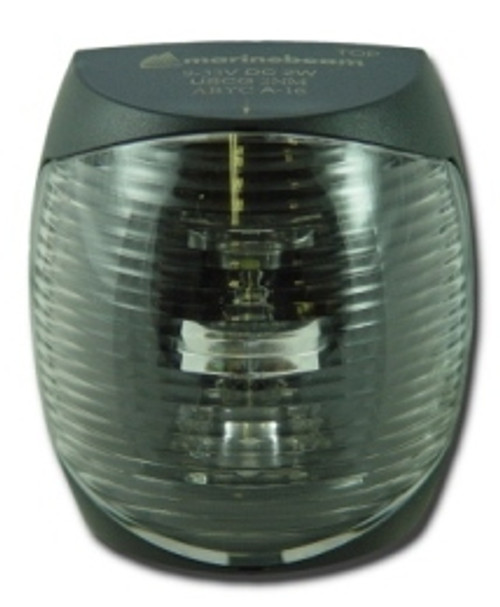
4 Reviews Hide Reviews Show Reviews
Masthead streaming lights.
Posted by James on 23rd Aug 2022
The light is well made and easy to install. Works great.
LED Masthead steaming light
Posted by John DeRuyter on 24th Jul 2021
Easy to install and high quality
Excellent Quality
Posted by john sockwell III on 24th Jul 2017
I have outfitted by boat with all lights from Marinebeam. Interior lighting as well as navigation lighting. No more replacing bulbs for me. The light output is excellent and the housings are well made.
Great LED Light
Posted by Pat on 26th Feb 2017
As with all products from Marinebeam this is well made and looks good. Brighter than we expected.
Recommended
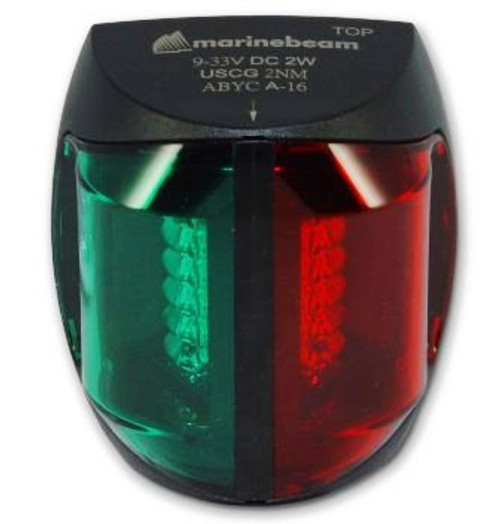
sku: N1-112-RGN
Led bi-color navigation light.

sku: N1-112
Led port/starboard navigation side lights.
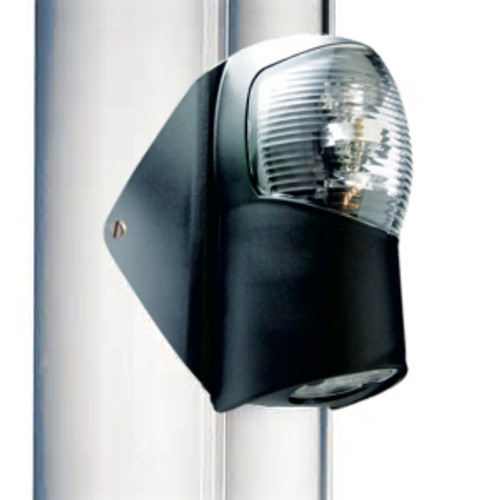
sku: N1-225-CMB
Led masthead/foredeck combination light.

sku: N1-135-CLR
Uscg 2nm led stern light.

- Forums New posts Unanswered threads Register Top Posts Email
- What's new New posts New Posts (legacy) Latest activity New media
- Media New media New comments
- Boat Info Downloads Weekly Quiz Topic FAQ 10000boatnames.com
- Classifieds Sell Your Boat Used Gear for Sale
- Parts General Marine Parts Hunter Beneteau Catalina MacGregor Oday
- Help Terms of Use Monday Mail Subscribe Monday Mail Unsubscribe
Steaming Light Replacement Question
- Thread starter pumpkinpie
- Start date Sep 19, 2019
- Hunter Owner Forums
- Ask A Hunter Owner
Anyone have a 2009 Hunter 38 that knows what replacement bulb is necessary for the steaming light? It is the original steaming light and I'm wanting to replace it with an LED light. I found the anchor light LED replacement but having issues with the steaming light. Any help is so much appreciated!
Rich Stidger
I can't help with the type of bulb, but I have to ask - "Why replace?" When you are motoring you have gobs of power. So the primary advantage of the LED is moot. Unless you find the incandescent bulb to be unreliable and require frequent replacement, why bother?
pumpkinpie said: Anyone have a 2009 Hunter 38 that knows what replacement bulb is necessary for the steaming light? Click to expand
Terry Cox said: Does your fixture look something like this? LED Masthead/Foredeck Combination Light If it does, you will want to replace the foredeck bulb as well. A picture of your fixture would help, absent any input from an H38 owner. Click to expand
quadrille38
Take a look at the Hunter 38 parts page on SBO site. Here is the navigation lights page Hunter 38 Nav Lights Parts There are two different steaming light fixtures shown. My 2008 has the combination deck / steaming light fixture that is the one of the bottom left of the page. If you ask the SBO store guys I’d be willing to bet that they can identify the bulb for you. As other poster suggested, I chose to not do LED for steaming light at this time. I was more focused on lights that would be on when the engine is not. Like running and anchor.
quadrille38 said: I was more focused on lights that would be on when the engine is not. Click to expand
Kings Gambit
pumpkinpie said: Which equals better visibility to other boaters keeping us a little safer at night. Click to expand
I probably should have stated in my original post that for whatever reason my steeming light and deck light are so dim and need to be replaced, regardless if it’s LED or OEM.
Terry Cox said: Makes sense, but from my perspective it made more sense to replace the incandescent bulb that has a useful life of maybe a few months, to an LED bulb that will outlast my life of use. Click to expand
Your issue, if the light is "dim" (but working) MAY be: i) a bad electrical connection which reduces the current to the bulb -- i.e., it's "dimmed"; or, ii) the lens has been yellowed by UV degradation or is just dirty (less likely). In my experience, an incandescent bulb isn't necessarily less bright than an LED light. I think old fashioned incandescent bulbs are more "forgiving" in terms of compromised electrical connections, and moisture. We replaced all of our Nav lights with LED's EXCEPT for our combo steaming and foredeck light. This year, after 21 years, the steaming bulb gave-out and we replaced it. Our NAV Lights are Hella's, I think they are the most durable and sealed the best.
- This site uses cookies to help personalise content, tailor your experience and to keep you logged in if you register. By continuing to use this site, you are consenting to our use of cookies. Accept Learn more…
- Vessel Reviews
- Specialised Fields
- Marine Projects
- Other Workboats
- Aquaculture
- Other Fishing
- Regulation & Enforcement
- Feature Weeks
- Classifieds
- Book Reviews
VESSEL REVIEW | Sinichka – Electric commuter boats designed for Russia’s Moskva River
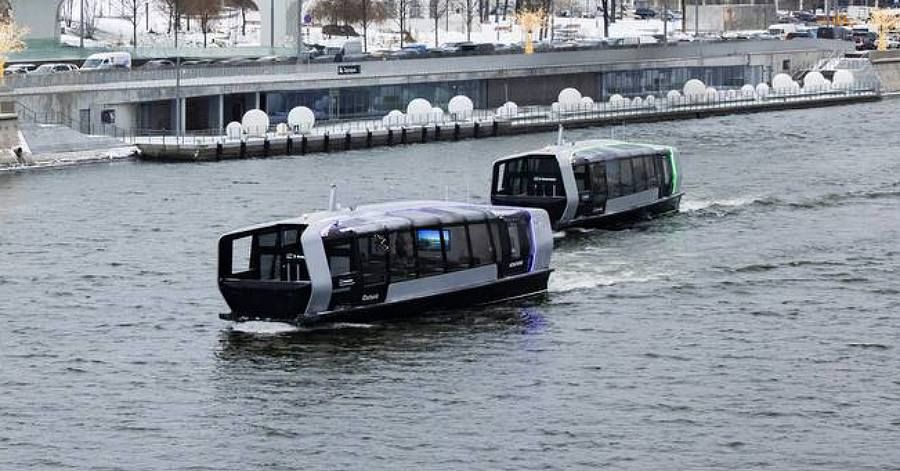
A series of three new electric monohull commuter ferries have already begun operational sailings on the Moskva River in the Russian capital Moscow.
Built by Russian shipyard Emperium, sister vessels Sinichka , Filka , and Presnya – all named after rivers in Moscow – are being operated by the Moscow Department of Transport and Road Infrastructure Development (Moscow Deptrans). They are the first units of a planned fleet of 20 vessels that will serve the capital city and other nearby communities. The new ferry system will be the water transport system to be operated on the Moskva River in 16 years.
Each vessel has a welded aluminium hull, an LOA of 21 metres, a beam of 6.2 metres, a draught of only 1.4 metres, a displacement of 40 tonnes, and capacity for 80 passengers plus two crewmembers. Seating is available for 42 passengers on each ferry, and the main cabins are also fitted with USB charging ports, wifi connectivity, tables, toilets, and space for bicycles and scooters. The cabin layout can be rearranged to allow the operator to adjust the distances between the seats and to install armrests of varying widths.
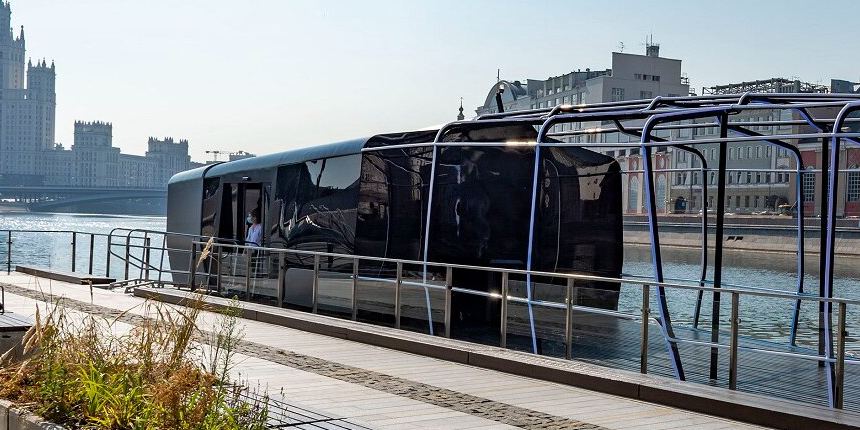
An open upper deck is also accessible to passengers and is the only area on each ferry where smoking is allowed.
The ferries are all of modular construction with each ferry’s wheelhouse, main cabin, and other structural elements being built as complete, separate components. This enables the ferries to be easily dismantled for transport to anywhere in Russia by rail and then quickly re-assembled within seven days.
The ferries are also ice-capable. Recently completed operational trials on the Moskva showed that the vessels can also easily navigate under mild winter conditions with broken surface ice, though year-round operations are planned for the entire fleet.
The ferries are each fitted with 500kWh lithium iron phosphate battery packs that supply power to two 134kW motors. This configuration can deliver a maximum speed of 11.8 knots, a cruising speed of just under 10 knots, and a range of 150 kilometres.
Emperium said the transfer of rotation of electric motors to the propeller is carried out by direct drive. As a propulsion installation, a pulling rotary propeller-steering column with double screws is used. The installation of double pulling screws, with similar power, allows an operator to increase the efficiency of the propulsion system to deliver a slightly higher speed or to reduce energy consumption. This arrangement also provides the ferries with enhanced manoeuvrability necessary for navigating in close quarters.
The batteries themselves have projected service lives of 10 to 12 years and are fitted with safety features such as built-in fire extinguishers and gas vents. Quick-disconnect features allow the batteries to be easily removed for replacement or maintenance.
Some of our readers have expressed disquiet at our publication of reviews and articles describing new vessels from Russia. We at Baird Maritime can understand and sympathise with those views. However, despite the behaviour of the country’s leaders, we believe that the maritime world needs to learn of the latest developments in vessel design and construction there.
Click here to read other news stories, features, opinion articles, and vessel reviews as part of this month’s Passenger Vessel Week.
Related Posts

Baird Maritime
Tags: Emperium Filka Moscow Moscow Department of Transport and Road Infrastructure Development Moskva River Presnya Russia Sinichka WBW newbuild
- Previous VESSEL REVIEW | Ferry Rokko – Second 194m Ro-Pax for Miyazaki Car Ferry
- Next Brighton man to be charged for illegal abalone haul

Baird Maritime , launched in 1978, is one of the world's premier maritime publishing houses.
The company produces the leading maritime new portal BairdMaritime.com , home of the world famous Work Boat World, Fishing Boat World, Ship World, Ausmarine, and Commercial Mariner sub-sites, and the industry-leading ship brokerage platforms WorkBoatWorld.com and ShipWorld.com .
Contact us: [email protected]
© Copyright - Baird Maritime
- Terms & Conditions
- Advertise with Baird Maritime
- Submit News/Leads
Moscow City Lights
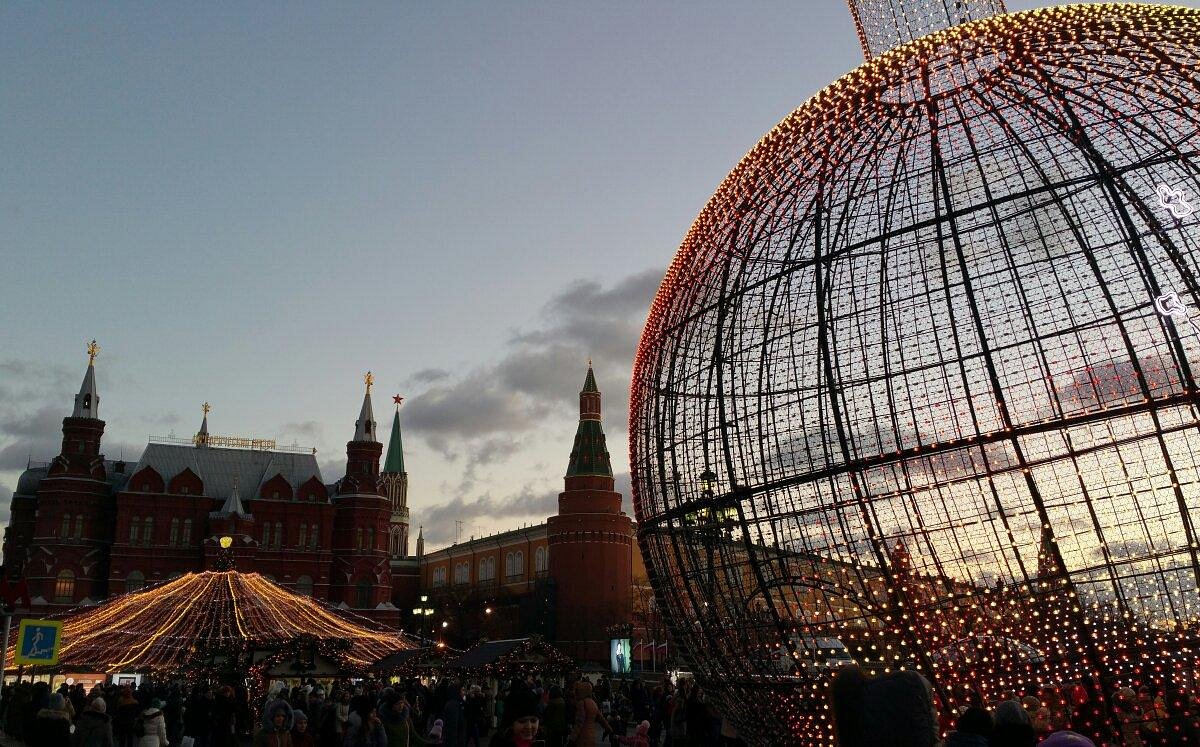
- See all photos

Most Recent: Reviews ordered by most recent publish date in descending order.
Detailed Reviews: Reviews ordered by recency and descriptiveness of user-identified themes such as waiting time, length of visit, general tips, and location information.

Moscow City Lights - All You Need to Know BEFORE You Go (2024) - Tripadvisor

IMAGES
VIDEO
COMMENTS
Knowing that the bow lights go 22.5 degrees abaft the beam on both sides or 112.5 degrees on each side, and the stern light faces 225 degrees aft for a total of 360 degrees of visibility, you can tell a lot about where a boat is heading and who has the right of way. One thing that's easy to remember is red means stop and if you see a vessel's ...
A steaming light is a white navigation light fitted on the mast of a sailboat to provide visibility during low-visibility conditions. It is typically placed near the front side of the mast and angled downwards to indicate that the vessel is under power and moving forward. This light helps other boats identify and avoid collisions, ensuring safe ...
According to the navigation rules the steaming light/mast light should be 1 meter above sidelights. In reality, I have seen mast lights a few feet above the spreaders and a few feet below the spreaders. My mast is 28 ft long . I have already installed the anchor light on top of the mast. Now, I only have to install the steaming light/mast light ...
For most small vessels, motoring requires red and green (port and starboard) lights, and a white light visible in all directions around the boat. This is almost always a stern light and a masthead light on sailboats. Boats under sail require port and starboard lights, and a white stern light. Sailboats below sixty-five feet may show a tricolor ...
A sailboat steaming light is a white, forward-facing light used to indicate that a vessel is underway under power during nighttime or restricted visibility conditions. It is typically mounted on the mast or near the navigation lights and helps other vessels identify the sailboat's position and direction.
The most common of our navigation lights are our "running lights". This is a red light on the port side of the boat and a green light on the starboard side that shine from the bow to 22.5 degrees abaft the beam of the boat. This creates a 112.5-degree arc on either side of the vessel. To complete a 360-degree circle, our white stern light ...
For a Steaming Light, there is no need to use an LED as the light is only on when the engine is running and there is plenty of power. 33 CFR 183.810 is the relevant law governing CG light approval. ... Not a big fan of masthead anchor lights, but then the biggest boat I have owned is an ODay 25 with a 3ft draft. With a shoal draft sailboat, I'm ...
Running Lights. When under power: You must use your navigation and steaming lights (at left). When under sail: Use either your masthead tricolor (second to left) or deck-level navigation lights (second to right), but not both. At anchor: You must display a white light that's visible through 360 degrees (at right).
Stern light. A white light mounted as close to the stern as possible and shines dead ahead in an arc of 135° (67.5° to each side). The mounting height should be aligned to the height of the side lights and should never be higher. 3. Three-colour light for sailing vessels (sailing lights) On sail boats up to a length of 20 m, the side light ...
The COLREGS state that the steaming light, on a vessel between 12m - 20m must have a range of at least 3nm, therefore the Lopolight 3nm Masthead light is a great choice. Stern Light - Lopolight 2nm stern. The stern light has an arc of 135 degrees and is used when a sailing vessel is motoring.
The light uses our 225° 2W sealed LED steaming light module, coupled with a high-output 4W LED deck light in a robust and UV-stabilized Black Nylon 66 housing. This lamp is designed to be mast-mounted to a wide variety of mast profiles using the flexible mounting "wings" which envelop the mast. Installs simply with two screws or rivets.
Foredeck Light, Masthead Combo Eco Series LED masthead steaming navigation light fixture with deck, 225 degree 2NM 3NM. Toggle menu (843) 885-8644 ... Combination LED Masthead Steaming Light and Foredeck Light for Sailboat Masts. Replaceable LEDs: 42mm Festoon (Steaming), MR16 (Foredeck) Input Voltage: 10 - 30VDC (Integrated Constant Current IC)
LED combination deck / steaming light. Meets Coast Guard requirements for yachts up to 65' LOA. Separate switching. LED bulbs are easily replaceable. Provided with 6" of triple-lead wire. Lightweight, rugged composite material. Measure 5 3/4" vertically. Molded body. Available in black finish only.
Sailboats with sails up during the day, but are also under power, must fly a black "steaming cone," with its point downward, where it can be seen. ... (65.7'), a masthead light must be visible for 3nm. All other lights must be visible for 2nm. Boat over 20m (65.7') and less than 50m (164') must display a masthead light visible for 5nm. All ...
Aug 20, 2003. #2. Steaming Light. The steaming light is just that, it is used when steaming/motoring. If it is on, in conjunction with the stern light, then the boat is signaling that is under power to all other vessels. You must then abide by the navigation rules for a motorized vessel even if you are under sail only.
COMBINATION DECK/STEAMING LIGHT- ML-2. Steaming Light meets Coast Guard requirements for yachts up to 65' LOA. Separate Switching for Deck and Steaming lights. 10 Watt Boy Light Bulb is easily replaceable (WN-211).8 amps. Deck Light features identical to ML-1. Provided with 6" of triple-lead wire. Weighs 7 oz - measure 5 ¾" vertically.
Five Oceans LED Tri-Color All-Around Anchor Boat Navigation Light, High Performance Polycarbonate Housing, 12V DC, Meets USCG 2 NM Rules, Mast Mount for Sailboat - FO4625 dummy ISURE MARINE Boat Yacht Navigation Anchor Lights All Round 360° White 12V LED Daylight Waterproof Signal Lights
Marinebeam's NavLight™ Series 1 3NM USCG-Certified 225° Masthead (Steaming) Light. These attractive and economical 225° white LED lights face forward on the boat's centerline, and are used to indicate that a vessel (up to 50 Meters in length) is underway and is power-driven. Used on motor-craft and sailboats under power.
Here is the navigation lights page Hunter 38 Nav Lights Parts There are two different steaming light fixtures shown. My 2008 has the combination deck / steaming light fixture that is the one of the bottom left of the page. If you ask the SBO store guys I'd be willing to bet that they can identify the bulb for you.
Walking tour around Moscow-City.Thanks for watching!MY GEAR THAT I USEMinimalist Handheld SetupiPhone 11 128GB https://amzn.to/3zfqbboMic for Street https://...
About Us. Baird Maritime, launched in 1978, is one of the world's premier maritime publishing houses.. The company produces the leading maritime new portal BairdMaritime.com, home of the world famous Work Boat World, Fishing Boat World, Ship World, Ausmarine, and Commercial Mariner sub-sites, and the industry-leading ship brokerage platforms WorkBoatWorld.com and ShipWorld.com.
Normally the boats sail between 10:00 a.m. and 9:00 p.m. although there are also companies that offer night cruises with dinner included. I recommend that you take advantage of the afternoons for a boat tour, when the monuments and museums are closed. Going on a night cruise to see the Moscow city lights is also a very good option.
Moscow City Lights. 16 reviews. #60 of 558 Nightlife in Moscow. Bar, Club & Pub ToursNight ToursPrivate Tours. Write a review. See all photos. About. Explore Moscow best bars and authentic food spots with the most hospitable team! Book a private bar tour - party like a true Russian!